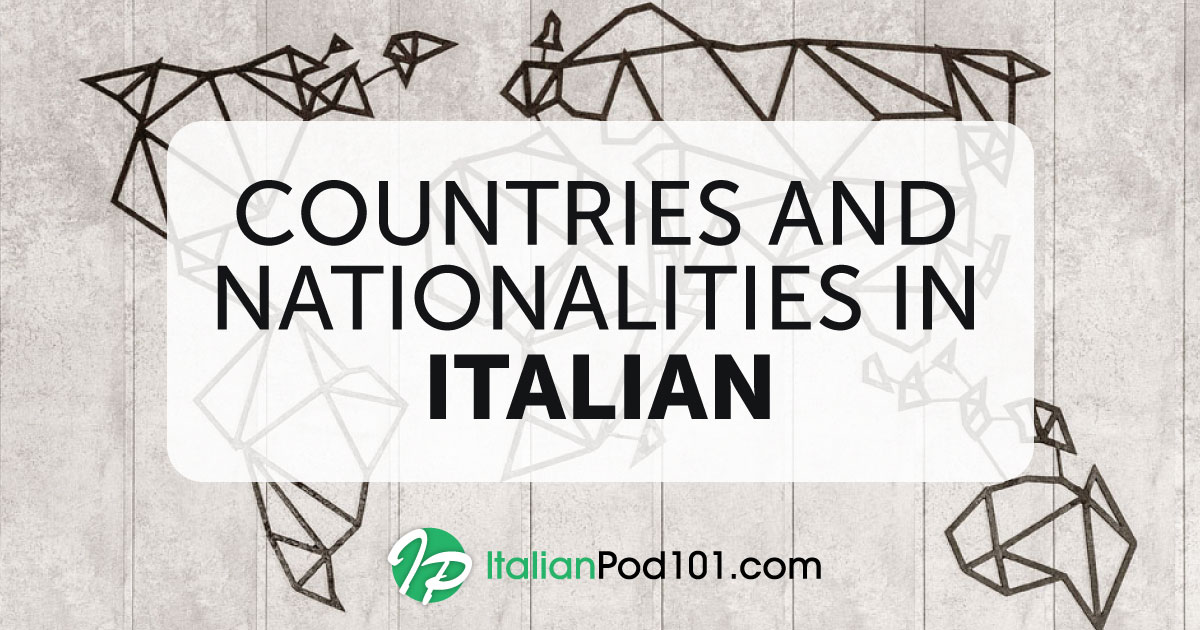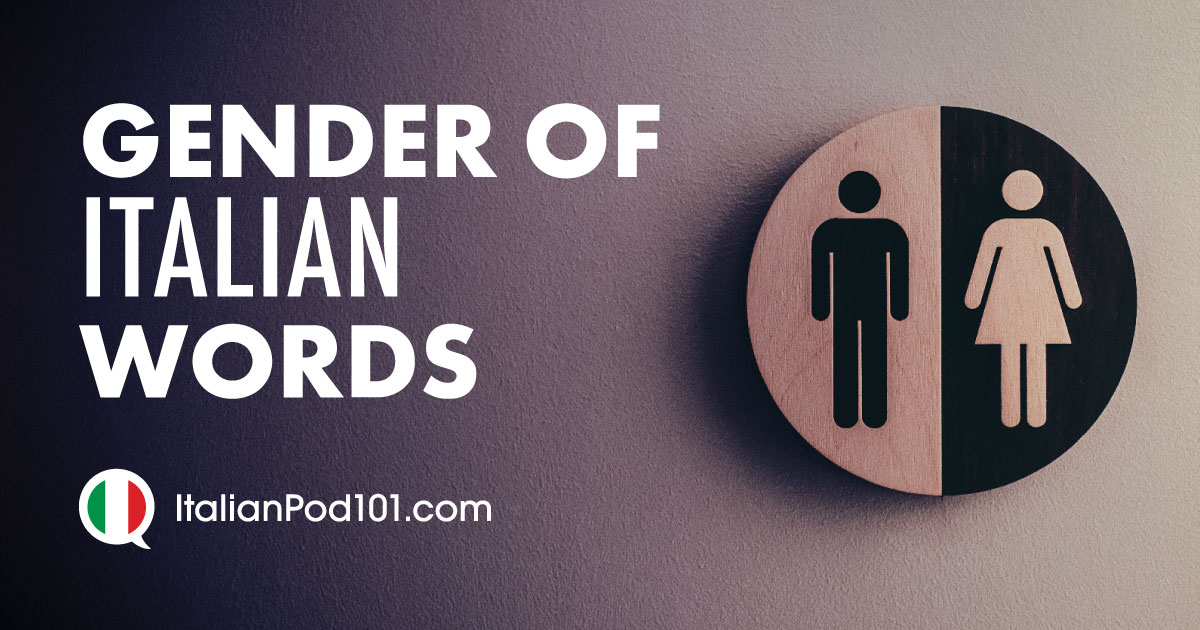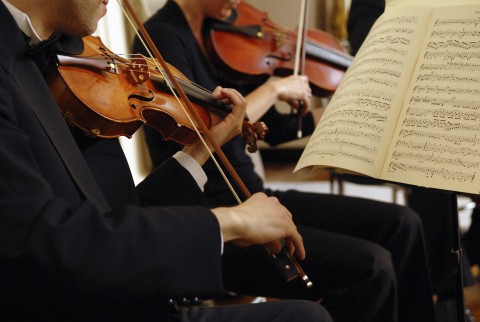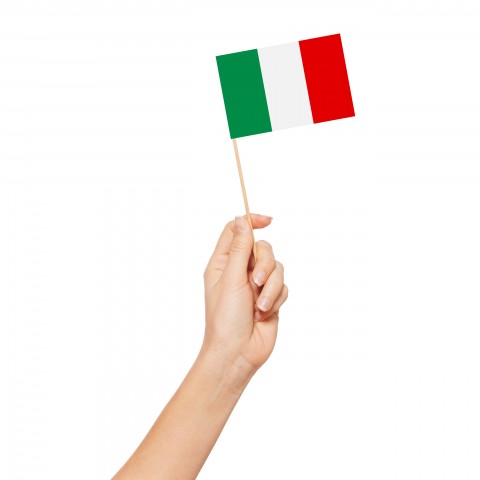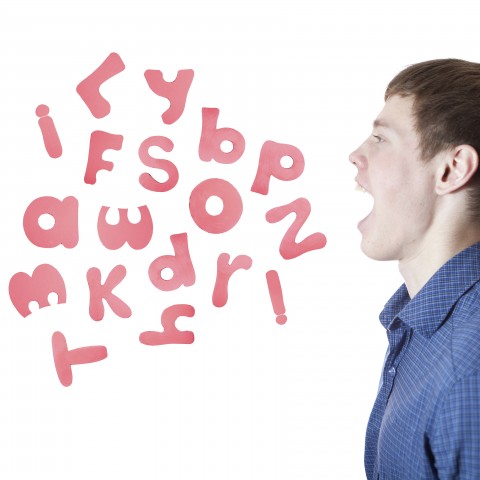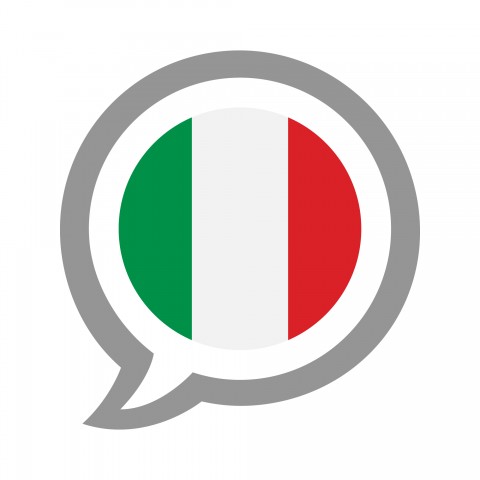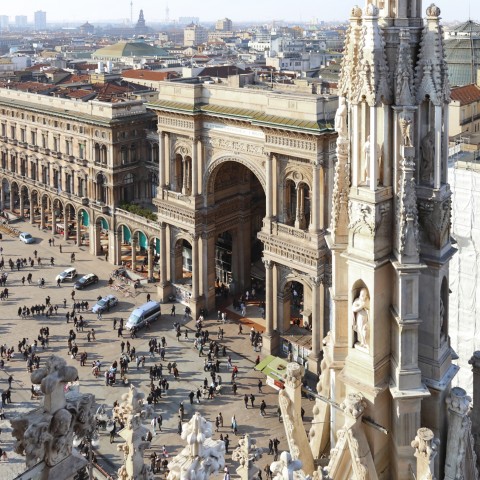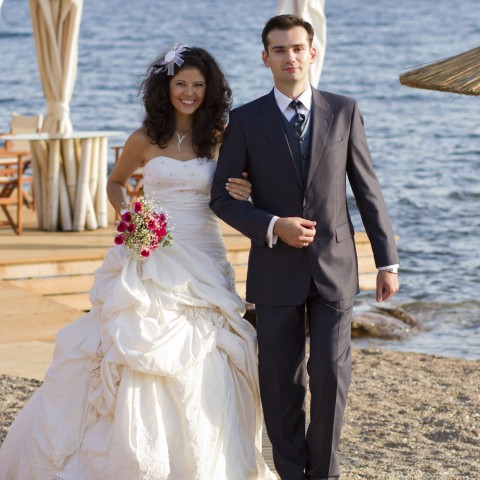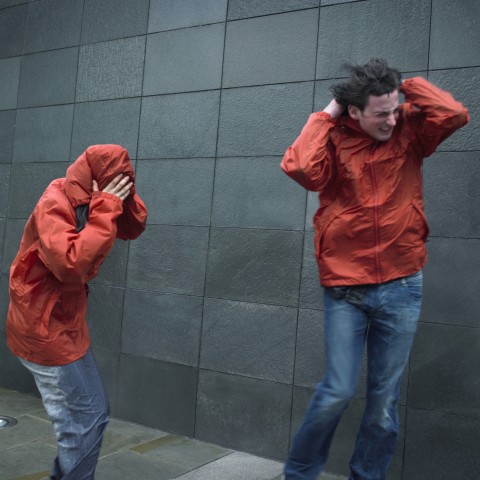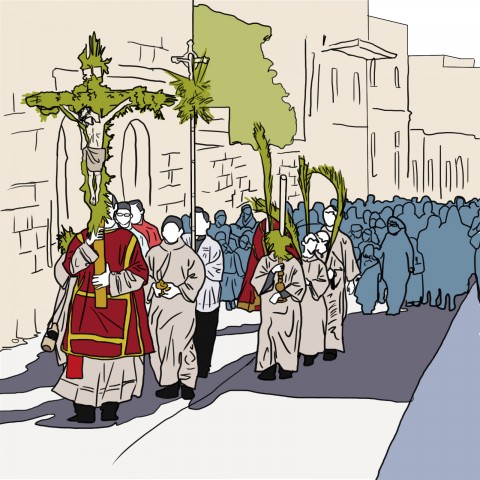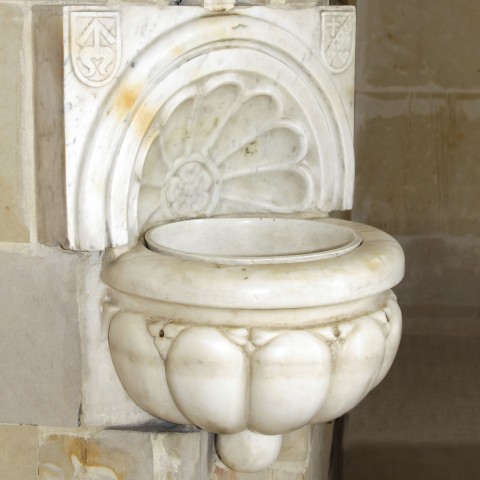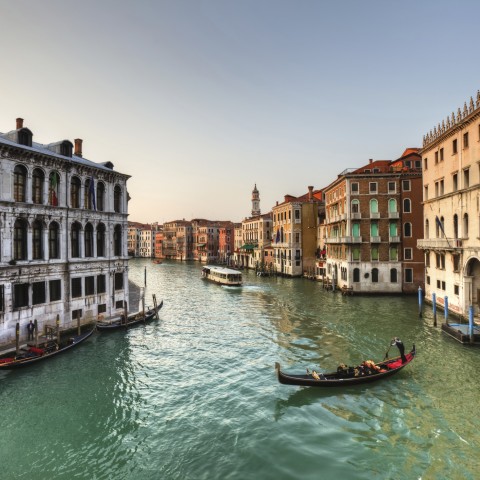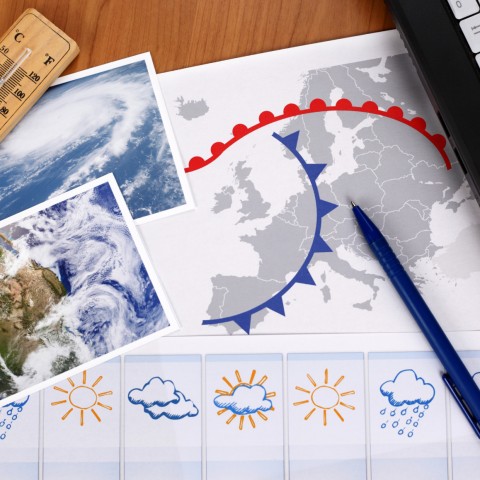
Are you traveling through Italy? Do you need to get to the Colosseum? Are you taking art classes in Florence?
If you’re in Italy and you want to enjoy getting around and exploring new places, get ready to ask for directions in Italian with this quick and easy guide. No need for maps or GPS if you can get a little help from locals and practice your Italian in the process.
In this article, I’ll be going over direction phrases in Italian, and will teach you words like “right” in Italian and much more!

Table of Contents
- On the Map: Cardinal Directions in Italian
- On the Road: Street Directions in Italian
- Directions in Italian Using Landmarks
- Italian Phrases for Asking (Politely) for Directions
- Must-know Italian Phrases for Giving Directions
- If You Get Lost
- Streets, Squares, and More (Much More!)
- Conclusion
1. On the Map: Cardinal Directions in Italian
Whether you’re old-school and like to rely on paper maps, or you’re more into new gadgets and like to get around with GPS apps, one of the first things to learn is how to ask for compass directions in Italian when planning your trip on a map.
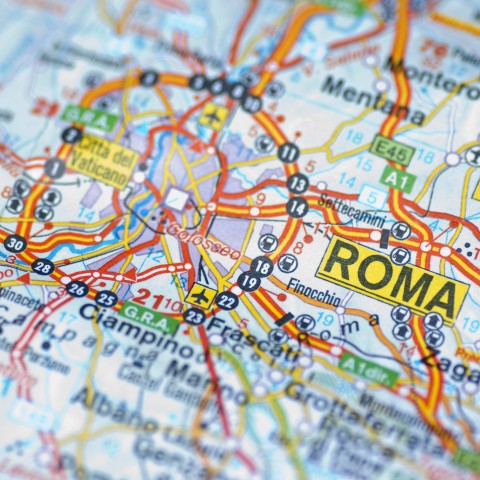 Tutte le strade portano a Roma. (“All roads lead to Rome.”)
Tutte le strade portano a Roma. (“All roads lead to Rome.”)
- Nord — “North”
- Sud — “South”
- Est — “East”
- Ovest — “West”
These (and their combinations nord-est, sud-ovest, etc.) are the essential words you need to learn to find your way around a map of the country. Other than that, Italians don’t have the habit of referring to cardinal points when giving directions, and they’re mainly used to indicating the parts and areas of Italy.
When talking about directions in English, it’s very common to say things like “go north on Second Street” (prosegui a nord su Second Street). Instead, Italians almost never use directions when giving directions. Italians mostly mention the directions when describing geographical features.
-
– Milano è nel nord d’Italia.
“Milan is in the north of Italy.”
– Napoli e Palermo sono le maggiori città del sud d’Italia.
“Naples and Palermo are the major cities in the south of Italy.”
– Pompei si trova a sud di Napoli.
“Pompeii is located south of Naples.”
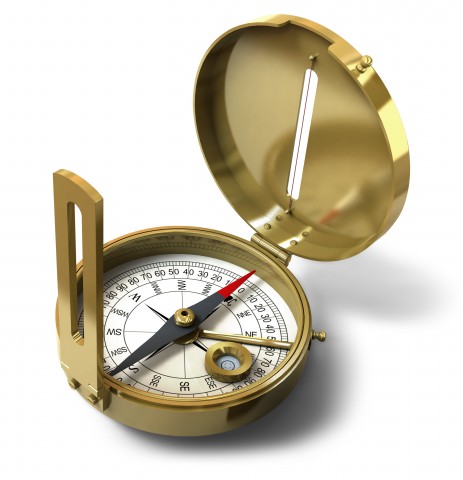 Hai perso la bussola? (Literally, “Did you lose your compass?” meaning also “Are you lost? Out of your mind?”)
Hai perso la bussola? (Literally, “Did you lose your compass?” meaning also “Are you lost? Out of your mind?”)
In Italy, you’ll never hear someone talking about the north part of the city. Instead, almost every city can be divided into il centro storico, or “the historical center,” historically the old part of town, and la periferia or “the outskirts”/”the suburbs,” which are the newer parts of the town.
2. On the Road: Street Directions in Italian

For road directions in Italian, you’ll need a series of relative indicators that will help you easily find where to go. Here are the most important ones:
| a destra; a sinistra | “to the right”; “to the left” |
| davanti; dietro | “in front”; “behind” |
| vicino; lontano | “near”; “far” |
| accanto a | “next to” |
| all’angolo; dietro l’angolo | “at the corner”; “around the corner” |
| da questo lato; dall’altro lato | “on this side”; “on the other side” |
| a [due minuti] di distanza | “it’s [two minutes] away” |
Notice to say “right” in Italian we say destra, but just in the sense of left and right. If you mean “right” as in “correct,” you’ll have to say giusto. Giusto?
-
A: È vicino il Duomo?
“Is the Duomo near?”
B: Saranno 5 minuti a piedi.
“It’s probably a five-minute walk.”
B: Prendi la prima a sinistra, poi la seconda a destra. Il Duomo è dietro l’angolo.
“You turn left at the first intersection, then turn right at the second intersection. The Duomo is around the corner.”
3. Directions in Italian Using Landmarks
When you’re traveling, there are so many landmarks that you’ll go to or pass by. So it’s important to know the names of the main public buildings and of all the places of tourist interest in a particular city. When asking for directions, make sure you know the following words and phrases:
Around the City
| l’aeroporto | “the airport” |
| la stazione (dei treni, degli autobus) | “the (train, bus) station” |
| l’accesso alla metro | “the access to the subway” |
| la fermata dell’autobus | “the bus stop” |
| il centro | “downtown” |
| il centro commerciale | “the shopping center” |
| il parco | “the park” |
| l’albergo; l’hotel; l’ostello | “the hotel”; “the hostel” |
| l’ospedale | “the hospital” |
| la banca; il bancomat | “the bank”; “the cash machine” |
| l’ufficio postale | “the post office” |
| il parcheggio dei taxi | “the taxi parking” |
| il museo; il teatro; il cinema | “the museum”; “the theater”; “the cinema” |
| la chiesa | “the church” |
| il ristorante; la trattoria; la pizzeria | “the restaurant”; “the tavern”; “the pizzeria” |
| il bar; la gelateria | “the coffee bar”; “the ice cream shop” |
| il supermercato; il mercato | “the supermarket”; “the market” |
| l’edicola | “the newsstand” |
| la farmacia | “the pharmacy” |
| la scuola | “the school” |
| il benzinaio; il distributore di benzina | “the gas station” |
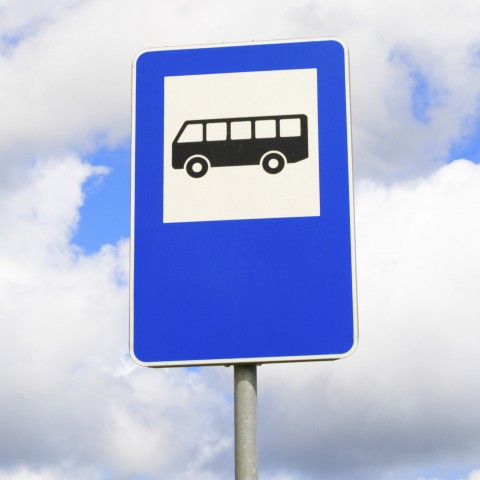 La fermata dell’autobus. (“The bus stop.”)
La fermata dell’autobus. (“The bus stop.”)
-
– La farmacia è di fronte all’ospedale.
“The pharmacy is in front of the hospital.”
– Per andare al supermercato, vai sempre dritto fino al benzinaio, gira a destra, poi continua fino al secondo semaforo e infine gira a sinistra.
“To go to the supermarket, go straight to the gas station, turn right, then continue to the second traffic light and then turn left.”
On the Street
| l’incrocio | “the intersection” |
| il semaforo (verde, rosso, giallo) [link to colors] | “the traffic light” (green, red, yellow) |
| le strisce pedonali (le strisce) | “the pedestrian crossing” |
| il marciapiede | “the sidewalk” |
-
– La fermata dell’autobus è a duecento metri dal semaforo.
“The bus stop is two-hundred meters from the traffic light.”
– Quando arrivi all’incrocio, attraversa sulle strisce pedonali e aspettami sul marciapiede.
“When you reach the intersection, cross on the pedestrian crossing and wait for me on the sidewalk.”
Inside a Building
| il bagno | “the toilet” (or bathroom) |
| l’ascensore | “the elevator” |
| le scale | “the stairs” |
| la porta; il portone; il cancello | “the door”; “the main door”; “the gate” |
| l’entrata; l’uscita | “the entry”; “the exit” |
| il parcheggio (la cassa per pagare il parcheggio) | “the parking” (the cash desk to pay the parking) |
-
– Dov’è il bagno?
“Where is the bathroom?”
– Per favore, potrebbe indicarmi l’uscita?
“Can you show me the exit, please?”
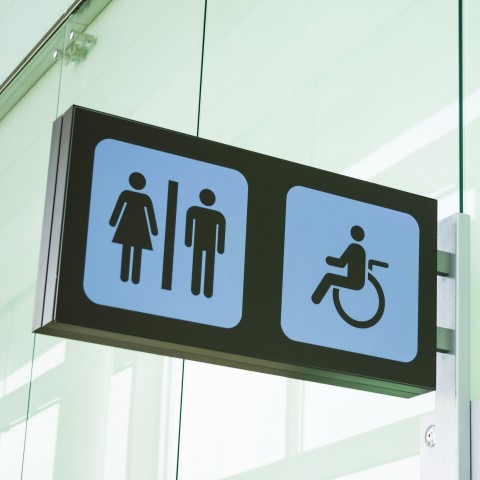 Scusi, dov’è il bagno? (“Excuse me, where is the bathroom?”)
Scusi, dov’è il bagno? (“Excuse me, where is the bathroom?”)
4. Italian Phrases for Asking (Politely) for Directions
If you want to make sure that you’re given the best directions to the place you want to go, you might want to master a few must-know phrases that will allow you to ask politely and make a great first impression on the person you’re asking. Italians are usually very happy to help a tourist, especially a foreign one, but courtesy always goes a long way.
Scusi…
The first and most important phrase when asking directions in Italian is Scusi (scusa for informal) which literally means “may you excuse,” but basically just serves to catch the attention of the other person. (If you need a quick refresher on when we use formal/informal in Italian, check out this video.) Whenever you ask for directions, make sure you always start with that.
-
– Ciao, scusa, dov’è la scuola?
“Hi, excuse me, where is the school?”
– Scusi, dove prendo l’autobus per il centro?
“Excuse me, where do I take the bus downtown?”
– Scusi, potrebbe darmi un’indicazione?
“Excuse me, could you give me an indication?”
Did you notice that often when we ask politely, we end up using the conditional tense? So now is a very good opportunity to check out uses and conjugations, don’t you agree?
Dov’è…?
When you want to know where a certain place is, you have a few different ways of saying it:
Dov’è / dove si trova / come si va (“where it is” / “where is located” / “how do you go”). They can all be used to ask directions to a specific place.
-
– Scusi, dov’è il supermercato più vicino?
“Excuse me, where is the closest market?”
– Scusi, dove si trova il bagno delle donne?
“Excuse me, where is the lady’s bathroom?”
– Come si va a Pompei?
“How do I go to Pompeii?”
Per favore
Kindness is never too much, especially when you’re asking a favor from a stranger, so you might want to add a few “please”s with your question. And how do you say “please” in Italian? Per favore, of course. And can you guess what favore literally means? A favor? Please…
-
– Scusi, potrebbe dirmi per favore come si arriva al Duomo?
“Excuse me, can you please tell me how to get to the Duomo?”

Quanto dista?
Not only do you need to get to your destination, but you also need to know how far/long it is to get there. You have many different ways to ask that:
- Quanto dista?
“How far is it?”
Literally: “How much it is distant?” - È lontano?
“Is it far?” - Quanto ci vuole?
“How long does it take?”
Literally: “How much [time] it’s necessary to get there?”
Grazie mille!
Once you have all the information you need, make sure you know how to properly thank the nice person who helped you get where you needed to. Grazie! (“Thanks!”) is obviously the basic appreciation, but if you want to get a bit fancier, you have a few more options:
- Grazie.
“Thank you.” - Grazie mille. or Mille grazie.
“Thank you very much.”
Literally: “Thank you a thousand.” - Grazie tante. or Tante grazie.
“Many thanks.” - Molto gentile.
“Very kind.” - La ringrazio. / Ti ringrazio. (formal / informal)
“Thank you.”
Literally: “I thank you.”
5. Must-know Italian Phrases for Giving Directions

Are you familiar enough with your whereabouts that you feel confident giving directions to other people? Well done! Here’s how to give directions in Italian with a few simple phrases. And always remember the basic rule: if you know the person you’re talking to, go ahead and use the tu (2nd person – informal); otherwise, stick to Lei (3rd person – formal).
On the Street
- vai — “go”
- continua/prosegui — “keep going”
- Dritto — “straight”
- torna indietro — “go back”
- fai un’inversione (a U) — “make a U-turn”
- gira / svolta — “turn”
- a destra / a sinistra — “to the right” / “to the left”
– Per il Colosseo, continua dritto.
“To the Colosseum, keep going straight.”
– La strada è interrotta, fai una inversione a U e torna indietro.
“The street is blocked, make a U-turn and go back.”
On the Stairs
- al ventesimo piano — “on the twentieth floor”
- primo, secondo, ecc., ultimo piano — “first, second, etc., last floor”
- prendere le scale — “take the stairs”
- prendere l’ascensore — “take the elevator”
- salire / scendere — “go up” / “go down”
- a che piano va(i)? — “What floor?”
– L’ufficio postale è al secondo piano.
“The post office is on the second floor.”
– Di solito prendo le scale, ma oggi vado all’ultimo piano e prenderò l’ascensore.
“I usually take the stairs, but today I will go to the top floor and will take the elevator.”
 A che piano va? (“What floor?”)
A che piano va? (“What floor?”)
To a Driver
When giving suggestions to your driver, unless he/she is a friend of yours giving you a ride, you should address the driver using the formal Lei. Here are some useful taxi directions in Italian:
- continui — “go on”; “keep going”
- può fermarsi? — “Can you stop?”
- può andare più veloce? — “Can you go faster?”
- ho fretta, sono in ritardo — “I’m in a hurry, I am late.”
- può andare più piano? — “Can you go slower?”
- Non ho fretta, questa non è la formula 1… — “I’m not in a hurry, this is not the Formula 1…”
– Può fermarsi in Piazza San Marco?
“Could you stop in San Marco square?”
– Devo prendere il treno, può andare più veloce?
“I have to take the train, can you go faster?”
6. If You Get Lost
Even if you know all the vocabulary and all the must-know Italian phrases, even with maps and GPS and written-down directions, getting a little lost is common when you travel in a foreign country. So, get prepared for that possibility.
But don’t worry about it because, first of all, Italians are a generous and helping people and they’ll love to help you find your way back. And second, getting lost and just wandering around for a bit isn’t such a bad thing after all. Don’t you agree?
- Mi sono perso/a. — “I got lost.”
- Non trovo… — “I can’t find…”
- Non so come arrivare… — “I don’t know how to get to…”
- Mi potresti/potrebbe aiutare? — “Could you help me?”
– Dove vado? Non so come arrivare in centro…
“Where do I go? I don’t know how to get to the center…”
– Penso di essermi persa. Mi potrebbe aiutare ad arrivare in Via Roma?
“I think I got lost. Could you help me to get to Roma street?”
 In Vespa per i vicoli di Roma. (“Riding a Vespa through Rome narrow streets.”)
In Vespa per i vicoli di Roma. (“Riding a Vespa through Rome narrow streets.”)
7. Streets, Squares, and More (Much More!)
Surely you won’t have any problem giving or understanding directions in English. But when people give you directions in Italy, they might use unfamiliar names to refer to places around the cities, especially the more historical ones. Here’s a useful list for you:
| Via | “Street” |
| Viale | “Avenue” |
| Vialetto | “Alley” (usually leading to a house) |
| Vicolo | Vicolo |
| Vicolo cieco | “Cul-de-sac” (also metaphorically) |
| Strada statale / strada provinciale | “State highway” / “provincial road” |
| Autostrada | “Highway” |
| Svincolo | “Junction”; “exit” (on a highway) |
| Casello (per il pedaggio) | “Toll gate” |
| Stazione di servizio | “Service station” |
| Piazza | “Square” |
| Rotonda, rotatoria | “Roundabout” |
In Italian, you can always use the diminutive form of a noun or an adjective to give it a slightly different meaning. And we do it all the time! So, don’t worry if you hear people telling you about vicoletti, stradine, cancelletti, portoncini, and porticine (“tiny alleys, narrow streets, mini-gates, and cute little doors”). If you still have some doubts, just check out how diminutive and other fun suffixes work.
Il centro di Napoli è pieno di vicoletti e stradine.
“Downtown Naples is full of tiny alleys and narrow streets.”
Cappuccetto Rosso vive in una casetta nel bosco.
“Little Red Riding Hood lives in a small house in the woods.”
8. Conclusion

Do you better understand directions in Italian now? Can you easily find your way around Florence, the Colosseum, Torre di Pisa, and the train to Pompei?
Good job! Now just keep going straight ahead (sempre dritto) to ItalianPod101.com for more fun and useful lessons to get you exactly where you need to be with your knowledge of Italian!
Happy learning!

The Most Useful Italian Compliments and Praise Words
Why is it important to study the most useful Italian compliments? Nothing makes people feel more important, appreciated, and good about themselves than compliments. By complimenting a girl, a friend, or a chef for their very good food, you set out to a good start in any relationship. Not to mention that the occasional compliment is an indispensable part of polite conversations.
First of all, let’s remember that the two most basic Italian compliments are bello/a (“beautiful,” “nice” ) and bravo/a (“good,” “able” ). We’ll see how they can be used in different ways, and how you can fare bella figura, or “make a good impression,” using these common Italian compliments and praise words.

Table of Contents
- Ciao bella! Complimenting Someone’s Look
- Complimenti! Complimenting Someone’s Work
- Bravo! Complimenting Someone’s Skills
- Che buono! Complimenting Food
- Come stai bene! Generic Compliments
- Grazie! What to Expect After Giving Compliments
- Che bel sorriso! How to Flirt in Italian
- Sembri più giovane! Compliments on Someone’s Aging
- Congratulazioni! You’ve Gotten to the End…
1. Ciao bella! Complimenting Someone’s Look
Italians can be very particular about looks, and they’ll definitely notice a person’s hairstyle, tan, and clothing choices and comment about it. This can be a genuine compliment or just a way to—subtly—point out if something is off… But don’t worry. What matters is being able to graciously accept and respond to the compliments.
Che bel gattino! (“What a cute little cat!” )
By far, the most common compliment in Italian is bello (“beautiful,” “nice” ), which can be used to both compliment a person’s look and to praise an object’s or animal’s appearance.
- Sei una bella ragazza. (“You are a beautiful girl.” )
- Sei un bel ragazzo. (“You are a handsome boy.” )
- Hai una bella macchina! (“She has a nice car.” )
- Puffi è un bel gattino! (“Puffi is a cute little cat.” )
Notice how the adjective bello has the particularity that its ending changes depending on how the next word starts, just like the definite article, as follows:
La ragazza >> bella ragazza
Il ragazzo >> bel ragazzo
Compliment phrases in Italian can take different forms:
- Come sei carino/a! (“How cute you are!” )
- Che begli occhi! (“What beautiful eyes!” )
- Quanto sei elegante! (“How elegant you are!” )
Notice how you can start a compliment in Italian with one of these conjunctions:
- Come (“How” )
- Che (“What,” but literally “that” )
- Quanto (“How,” but literally “how much” )
Now, receiving compliments is all too nice, but there also exists a whole different aspect of complimenting someone’s look. This is the—rather annoying—compliments to passing women in the street. This is, unfortunately, a practice quite common in Italy, especially in the past. Nowadays, things are slowly changing and Italian men have started to realize that random compliments from a stranger are not welcome. So, if you’re a woman visiting Italy, be prepared that you might receive some unwanted compliments on the street, and try to avoid the typical Italian cascamorto (“skirt-chaser” ).
2. Complimenti! Complimenting Someone’s Work
Cooperation and partnership in the workplace are very important. So make sure you know how to compliment a job well done, a good performance, or a brilliant idea.
Ottimo lavoro! (“Great work!” )
- Hai fatto un bel lavoro. (“You did a good job.” )
- Che progetto ben fatto. (“What a well-made project.” )
- Bellissima presentazione. (“Very good presentation.” )
- Ottima idea. (“Great idea.” )
- Complimenti. (“Congratulations.” )
- Congratulazioni. (“Congratulations.” )
We’ve seen how the Italian word bello is used to refer to aesthetic beauty, but in this case, it can also refer to something that is good quality-wise.
As you can see, there are two different Italian compliment words to express “Congratulations,” and they’re used in different contexts:
-
– Complimenti is used to praise somebody who behaved well, passed an examination, or achieved some other accomplishment: Complimenti per la presentazione, è stata veramente interessante. (“Congratulations on the presentation; it was really interesting.” )
– Congratulazioni is used for promotions, marriages, or having a baby: Ho saputo che hai avuto una promozione. Congratulazioni! (“I heard you got a promotion. Congratulations!” )
3. Bravo! Complimenting Someone’s Skills
Bravooooooo!
Have you ever been to a concert or a play? Have you ever been to Teatro alla Scala in Milan? At the end of a performance, if the show was good, everybody stands up shouting “Bravo!” That’s a typical example of how to praise somebody for something good or well done. Bravo is a word that’s used in theaters and concert halls all over the world, but only in its masculine form, even if you’re complimenting a woman. In Italian, however, like every other adjective, bravo needs to agree in gender and number with the person (or people) you’re complimenting.
- Brava, Maria, scrivi proprio bene! (“You are good, Maria, you write really well!” )
- Bravo Marcello, corri molto veloce! (“You are good, Marcella, you run really fast!” )
- Bravi bambini, siete stati molto buoni oggi! (“Good kids, you have been very good today!” )
Bravo can also be used to praise a specific activity:
Che bravo/a ____!
- Che bravo fotografo! (“What a good photographer!” )
- Che brava attrice! (“What a good actress!” )
You can also use bello as a way to compliment the product of an activity:
Che bello ____!
- Che belle foto! (“What nice photos!” )
- Che bella interpretazione! (“What a beautiful interpretation!” )
When you compliment someone in Italian, it doesn’t hurt to exaggerate a little. Here’s a list of adjectives that will increase the power of your praises:
- Fantastico (“Fantastic” )
- Meraviglioso (“Wonderful” )
- Stupendo (“Superb” )
- Eccezionale (“Awesome” )
- Formidabile (“Fantastic” )
- Splendido (“Beautiful” )
- Incredibile (“Unbelievable” )
Another way of complimenting someone for doing something well—such as speaking Italian, cooking, or performing a sport—is to use the following construction:
Come ____ bene!
- Come cucini bene! (“How well you cook!” / “What a good cook!” )
- Come parli bene l’italiano! (“How well you speak Italian!” )
- Come giochi bene a calcio! (“How well you play soccer!” )
4. Che buono! Complimenting Food
Italians love food. They love to make it. They love to eat it. They especially love to talk about it… So, it’s just natural that they expect to be praised when they’re cooking and to praise (or criticize) when they’re eating. Let’s look at some Italian compliments for food!
Mmm.. Faccio il bis! (“Mmm… I go back for seconds!” )
Here’s the survival list of food compliments in Italian:
Che buono/a! is the first and most important compliment you can say about any dish. It means “good” in a general sense, but when it comes to food, it means “tasty” or “delicious.” Feel free to use or include any of the exaggerated adjectives that were listed before!
- Che buono! Posso assaggiare? (“So good! Can I taste it?” )
- Il pesto genovese è delizioso. (“Genoa pesto is delicious.” )
- La lasagna della nonna è buonissima! (“Grandma’s lasagna is very good!” )
- La pizza fatta in casa è eccezionale! (“The homemade pizza is awesome!” )
- Questo gelato è fantastico! (“This ice cream is fantastic!” )
However, the best compliment you can make to an Italian cook is to eat and come back for more. This is better than any praise:
- È buonissimo! Posso averne ancora? (“It’s good! Can I have some more?” )
- Mi piace un sacco! Faccio il bis. (“I really like it! I’ll go back for seconds.” )
An even better compliment is to ask about the ingredients and to ask for the recipe:
- È delizioso. Mi dai la ricetta? (“It’s delicious. Can you give me the recipe?” )
- Che piatto fantastico! Come lo prepari? (“What a fantastic dish! How do you prepare it?” )
And finally, whether you’re at a restaurant or at somebody’s house, the classic compliment for food is the good old: Complimenti al cuoco/alla cuoca! (“My compliments to the chef!” )
5. Come stai bene! Generic Compliments
Come stai bene! is a generic compliment that you can use for many different occasions. This is because it conveys a general sense that the person you’re complimenting looks good, feels good, or has something good about him/her. It’s often followed by a question to get more details about the specific compliment:
Looks:
- Come stai bene, sei andata dal parrucchiere? (“You look nice, did you go to the hairdresser?” )
- Come stai bene, sei stato al mare? (“You look nice, did you go to the beach?” )
Fitness:
- Come stai bene, stai andando in palestra? (“You look good, are you exercising?” )
- Come stai bene, stai facendo una dieta? (“You look nice, are you on a diet?” )
Clothing:
- Come stai bene in rosso. (“The color red suits you.” )
- Come stai bene, è un vestito nuovo? (“You look nice, is it a new dress?” )
Il rosso ti sta bene. (“Red suits you.” )
When talking about clothes, most Italians are happy to be praised regarding their style. The way to do that is to make a compliment that not only praises the piece of clothing or the accessories, but also the way the person is wearing it, and how beautiful he or she looks in it. Here’s how you do that:
Come ti sta bene ____ !
- Come ti sta bene questo cappotto! (“How good you look in this coat!” )
- Come ti stanno bene questi occhiali! (“How good you look with these glasses!” )
And everybody loves a casual mention of elegance and style: Che eleganza! Che stile! (“What elegance! What style!” )
6. Grazie! What to Expect After Giving Compliments
In Italy, we generally like to receive compliments and to be praised. Who wouldn’t? But even so, people often respond to compliments by shying away, pretending that they don’t really deserve it, or that it’s not a big deal. But it is! Trust me…
So, while the general response to compliments is thankfulness:
- Grazie. (“Thank you.” / “Thanks.” )
- Grazie mille. (“Many thanks,” but literally “a thousand thanks” )
- Che gentile! (“How kind!” )
- Che carino! (“How nice!” )
…others prefer a somewhat shy response:
- Ma figurati… (“Do not even mention it…” )
- Mi fai arrossire… (“You make me blush…” )
- Mi metti in imbarazzo… (“You embarrass me …” )
7. Che bel sorriso! How to Flirt in Italian
Of course, we couldn’t do without a chapter dedicated to romantic Italian phrases and flirting in Italian. After all, Italy is one of the most romantic places on earth, and the native country of Rodolfo Valentino, the father (or grandfather) of all Latin lovers.
Che bel sorriso…? (“Beautiful smile…?” )
Interesting fact: The word “flirting” (flirtare) has recently entered the Italian dictionary (it’s pronounced flertare). Of course, the compliments you use when flirting are different depending on if they’re for a man or for a woman. Also, while flirtatious compliments can get very creative and even funny, in most cases, you just need to praise the object of your desires in the most common way. The only important thing is to be sincere.
Italian compliments for a woman:
- Come sei carina! (“How cute you are!” )
- Come sei dolce! (“How sweet you are!” )
- Sei una bella ragazza/donna. (“You are a beautiful girl/woman!” )
- Che begli occhi! (“Nice eyes!” )
- Che bel sorriso! (“Beautiful smile!” )
- Sei molto simpatica! (“You are very nice!” )
Italian compliments for a man:
- Sei un tipo interessante. (“You’re an interesting guy.” )
- Come sei divertente! (“You are funny!” / “You make me laugh!” )
- Che belle mani! (“You have beautiful hands!” )
- Che muscoli! (“What muscles!” )
- Che bel sorriso! (“Beautiful smile!” )
- Sei molto simpatica! (“You are very nice!” )
8. Sembri più giovane! Compliments on Someone’s Aging
Are you about to go and meet a friend’s sweet grandma? In that case, when talking to the nonna (or other elderly member of the family), remember that talking about age isn’t exactly a taboo. It’s just a topic to be treated with delicate care. And there’s always a subtle way to make compliments on somebody’s age and to avoid embarrassing missteps.
75? Li porti benissimo! (“You don’t look at all 75!” )
Whenever the topic of age comes up in conversation, you’re “supposed” to praise the person for not showing their age. There are many ways to do that, and the person you’re complimenting will be grateful to hear any of them:
- Sembri più giovane. (“You look younger.” )
- Li porti bene/benissimo. (Lit. “You wear them very well,” means “You don’t look your age”. )
- Ti davo dieci anni di meno! (“I would give you ten years less.” )
- Non li dimostri per niente! (“You don’t show them at all!” )
9. Congratulazioni! You’ve Gotten to the End…
You deserve to be praised for all the hard work you’re putting into learning Italian. Now you can take advantage of all the great resources you can find at ItalianPod101. Grammar lessons, vocabulary lists, and language practice. Everything you need to keep improving your Italian skills!
Practice is always the best strategy to improve your Italian grammar, vocabulary, and communication skills. So make sure you visit ItalianPod101. Here, you’ll find a great number of free resources, podcasts, lessons, and even mobile apps, and a FREE PDF with practical and efficient lessons. Keep up your good work on your Italian learning!
In the meantime, if there’s anything in this lesson you didn’t quite understand, feel free to leave us a comment and we’ll do our best to help you out! What’s your favorite Italian compliment?

M or F? A Quick Guide to Italian Gender Rules
Why is it important to study Italian gender rules? Unlike in English, gender in Italian is the first characteristic of every noun. In Italian, everything has a gender, and you need to know which gender it is to use a noun with the correct article, adjective, or pronoun. When you search for a word in an Italian dictionary, you’ll always find the gender next to it (m/f).
You won’t find a neutral gender for Italian names, but from day one of your Italian class, you’ll start hearing that everything has to “agree.” This means that all parts of the phrase have to be in accordance with the word gender (and number).
So, here we go with a simple grammar guide about the gender of nouns in Italian.

Table of Contents
- What is Word Gender?
- How to Make a Good Guess on the Gender of a Word
- How to Memorize the Gender of Italian Nouns
- Gender Agreement for Articles and Adjectives
- Irregulars and Weird Exceptions
- Names with Totally Different M./F. Equivalents
- Conclusion
1. What is Word Gender?
Femminile o Maschile? (Feminine or Masculine?)
In Italian, there are two gender categories: Femminile (“Feminine” ) and Maschile (“Masculine” ). This means that there is no neutral gender.
This might sound a bit strange, but in Italian, objects such as chairs (la sedia, f.) and tables (il tavolo, m.), animals such as lions (il leone, m.) and tigers (la tigre, f.), feelings such as doubt (il dubbio, m.) and happiness (la felicità, f.) have a m/f gender, and you need to memorize which word is what gender. The best way to do this is to practice repeating the noun together with the right article; the article always shows you clearly what the gender of the word is.
Some words, such as the names of animals, have feminine/masculine equivalents that sometimes have a different form, like mucca/toro (“cow/bull” ) or gallina/gallo (“hen/rooster” ). These are mostly farm or pet animals. Other wild animals have an assigned gender in the Italian language (by whom, I ask myself…?),such as una tigre (“a tiger,” f.) and un rinoceronte (“a rhinoceros,” m.). If you want to make a word feminine, you’ll have to add femmina or maschio (“female” or “male” ) next to it. For example, un rinoceronte femmina (“a female rhinoceros” ).
Un rinoceronte femmina. (“A female rhinoceros.” )
This is also the case for professions. If there’s no feminine equivalent, you should add donna (“woman” ) after the name of the profession to solve any ambiguity: un ingegnere donna (“a woman engineer” ).
2. How to Make a Good Guess on the Gender of a Word
Besides looking up the gender in the Italian dictionary, there are basic gender rules in Italian to follow to understand if a word is feminine or masculine. The easiest clue is to check the ending of the word as, generally, words ending in -o (plural ending in -i) are masculine while words ending in -a (plural ending in -e) are feminine.
- Questo libro (m) ha una bella copertina (f).
“This book has a nice cover.” - La mia casa (f) è bella e comoda.
“My house is nice and comfortable.”
That sounds pretty straightforward, but things get a bit more complicated because there are a bunch of words ending in -e that could be either gender. Don’t worry, there are a few Italian language gender rules, but you’ll just need to memorize the words that don’t fit these rules. It’s hard work at the beginning, but soon you’ll get the hang of it.
- Il nostro è un amore (m.) infinito.
“Ours is an infinite love.” - Ho trovato la tua lezione (f.) molto utile.
“I found the lesson very useful.”
3. How to Memorize the Gender of Italian Nouns
Now you have the main rule (-o is masculine and -a is feminine), but what you really need is some tips to quickly know and memorize the gender of other Italian words. Here’s a list of endings that have a certain consistency and will help you determine the gender:
- Are feminine:
- All names ending in -ione (stazione; stagione; opinione) (“station”; “season”; “opinion” ).
A Milano c’è una stazione molto bella. (“Milan has a beautiful train station.” )
L’estate è la stagione più calda. (“Summer is the hottest season.” ) - Names ending in -tà or -tù (città; felicità; virtù; gioventù) (“city”; “happiness”; “virtue”; “youth” ).
Roma è la città eterna. (“Rome is the eternal city.” )
Hai visto il film ‘La meglio gioventù?’ (“Did you see the movie The Best of Youth?” ) - Most names ending in -i in the singular (crisi; sintesi) (“crisis”; “synthesis” ).
Hai fatto una sintesi molto chiara. (“You did a very clear synthesis.” )
La crisi di governo è prossima. (“The government crisis is close.” ) - Most names of fruit (banana; pera; mela) (“banana”; “pear”; “apple” ).
Questa mela è dolcissima. (“This apple is very sweet.” )
- Names of the sciences and other abstract notions (chimica; fisica; giustizia; pace) (“chemistry”; “physics”; “justice”; “peace” ).
La matematica è bellissima! (“Math is beautiful!” )
La pace è femminile! 😉 (“Peace is feminine!” ) 😉
- All names ending in -ione (stazione; stagione; opinione) (“station”; “season”; “opinion” ).
- Are masculine:
- All names ending in -ore (calore; attore; professore; ecc.) (“heat”; “actor”; “professor”; “etc.” ). Notice how nouns of professions ending in -tore are made feminine with the -trice ending, as in attore >> attrice (“actor >> actress” ).
Oggi c’è un calore intenso. (“Today there is an intense heat.” )
Hai incontrato il mio professore? (“Did you meet my professor?” ) - Most names of trees (melo; pero) (“apple tree”; pear tree” ). While in English, to make the name of a fruit tree, you have to add “tree,” in Italian you just switch the gender of fruit from feminine to masculine…rather convenient, right?
Maria è caduta dal pero. (“Maria fell off the pear tree.” )
Fun fact: Did you know that cadere dal pero is an idiomatic expression meaning that you were oblivious of something? Maybe this is because pear trees are rather tall and common in Italy; to be on top of it means that you’re less in contact with reality…
Cadere dal pero (“To fall from the pear tree” ) really means “to have no idea.”
- Greek origin names ending in -ma (problema; sistema; teorema) (“problem”; “system”; “theorem” ).
Questo problema è molto serio. (“This problem is very serious.” )
Non ho mai capito il teorema di Pitagora. (“I have never understood Pythagoras Theorem.” )Notice how, even if they end in -a in the singular, the plural of these names in -ma of Greek origin have a masculine regular plural in -i (il problema >> i problemi).
- All names of foreign origin ending in a consonant (bar; sport) (“bar”; “sport” ).
Il mio sport preferito è la pallacanestro. (“My favorite sport is basketball.” )
Questo è il bar dove servono il caffè migliore della città. (“This is the bar where they serve the best coffee in town.” ) - Names of (most) professions ending in -ta (poeta; pilota; astronauta). Note that some of them become feminine using the -essa ending, as in poetessa while others don’t change, such as la pilota or la giovane astronauta).
Il più grande poeta Italiano è Dante. (“Dante is the greatest Italian poet.” )
- Names of months and days (except for domenica (f) = “Sunday”).
È stato il dicembre più caldo del secolo! (“It was the hottest December of the century!” )
- All numbers (except for numbers indicating hours).
Il tre è il numero perfetto. (“Three is the perfect number.” )
Il 99% degli Italiani adora la pizza! (“99% of Italians love pizza!” )
- All names ending in -ore (calore; attore; professore; ecc.) (“heat”; “actor”; “professor”; “etc.” ). Notice how nouns of professions ending in -tore are made feminine with the -trice ending, as in attore >> attrice (“actor >> actress” ).
Are you ready for a little practice? Can you tell the Italian grammar gender of the nouns listed in this video?
4. Gender Agreement for Articles and Adjectives
Let’s talk about the dreaded concordanza (“the agreement” ). First things first, in Italian, most nouns need to be introduced by the article (determinate or indeterminate) and they have to agree in gender (and number) with the noun.
So, in order to memorize the gender of the words (besides the few Italian noun gender rules mentioned above), the best way is to memorize article + noun as a unique entity. The article always tells you clearly what the gender is.
-
– la lezione (f.) (“the lesson” )
– il fiore (m.) (“the flower” )
Here’s a little reminder of the way m./f. definite and indefinite articles change their form according to phonetic rules:
| Determinate Masculine Article (the) | ||
|---|---|---|
| Sing. | Pl. | |
| il | i | This is the regular form and is more commonly used. |
| lo | gli | This form is used in front of nouns starting with specific letters:
|
| Determinate Feminine Article (the) | ||
|---|---|---|
| Sing. | Pl. | |
| la | le | Same as for the masculine, in front of a vowel, the article la >> l’:
|
| Indeterminate Masculine Article (a/an) | ||
|---|---|---|
| un | This is the more commonly used form in front of a consonant or a vowel:
|
|
| uno | This form is used in front of nouns starting with S+consonant, z, x, y, gn, and ps:
|
|
| Indeterminate Feminine Article (a/an) | ||
|---|---|---|
| una | In front of a vowel, the article una >> un’:
|
|
So, we were talking about the agreement: all variable parts of the sentence have to agree with the gender (m./f.) and the number (sing./pl.) of the noun. Variable parts are:
-
– Articles (definite/indefinite)
– Adjectives
– Possessive adjectives (my; yours)
– Demonstrative adjectives (this; that)
– Indefinite adjectives (some)
– Pronouns (him; her; it)
– Past participle
Let’s analyze a sentence like this one, where the main noun is masculine (bambino = “kid” ):
Il mio bambino (m) é andato a scuola. (“My kid went to school.” )
Article + possessive + noun + (verb) + past participle; they all agree to the masculine form, except for the object (a scuola).
Or let’s take this one:
Nessuna pizza (f) è buona come questa. (“No pizza is as tasty as this one.” )
Indefinite + noun + (verb) + adjective + demonstrative; they all agree to the feminine form, except the verb.
Notice how the verbs don’t have to agree with the gender in Italian. But you do have to ensure that the past participle, which is part of the passato prossimo (“present perfect” ), agrees when it’s conjugated with the essere (“to be” ) auxiliary verb. But this will be part of another lesson coming up shortly about Italian conjugations on ItalianPod101.com!
Finally, one of the main consequences of all these Italian grammatical gender rules is that when you speak or write in Italian, you first have to think of the gender of the main noun, and then you can form the sentence accordingly.
5. Irregulars and Weird Exceptions
As usual, when it comes to syntax and grammar, there are exceptions. In particular, you might find nouns that look masculine because they end in -o but are feminine. These feminine -o nouns are often shortened words, such as:
- la radio (“radio” ) is short for radiotrasmettitrice
- la foto (“photo” ) is short for fotografia
- la moto (“bike” ) is short for motocicletta
- l’auto (“car” ) is short for automobile
È una moto? No, è una Vespa! (“It’s a motorcycle? No, it’s a Vespa!” )
Similar, but opposite, is the case of il cinema (short for cinematografo.)
A little different is the case of la mano (“hand” ) because it’s not the shortened version of anything.
Then there are names, mainly of professions, that have the same ending of -ista or -a, and can be either masculine or feminine. And this is a typical situation where you have to rely on the article, agreement, or purely the context, to figure out the gender.
Ending in -ista: il/la turista (“the tourist” ); il/la dentista (“the dentist” ); il/la giornalista (“the journalist” ).
-
– La turista è contenta. (“The tourist is happy.” )
– Questo giornalista sportivo scrive per la Repubblica. (“This sports’ journalist writes for la Repubblica.” )
Ending in -a: il/la collega (“the colleague” ); lo/la psichiatra (“the psychiatrist” ).
-
– Il mio collega mangia sempre in ufficio. (“My colleague always eats in the office.” )
– È un bravo psichiatra. (“He is a good psychiatrist.” )
Notice how in both cases, the plural of these nouns in -ista/-a ends in -e for feminine and in -i for masculine:
- La turista >> Le turiste
- Il turista >> I turisti
- La collega >> Le colleghe
- Il collega >> I colleghi
Then there’s the most bizarre of all cases: when a noun changes gender according to the number, that is, if it’s singular or plural. There are not—luckily—too many of those, but they are very common words:
| Singular is masculine | Plural is feminine | |
|---|---|---|
| L’uovo | Le uova | “The egg/s” |
| Il dito | Le dita | “The finger/s” |
| Il braccio | Le braccia | “The arm/s” |
| Il paio | Le paia | “The pair/s” |
| Il riso | Le risa | “The laugh/s” |
| L’osso | Le ossa | “The bone/s” |
| Il lenzuolo | Le lenzuola | “The sheet/s” |
| Il muro | Le mura | “The walls” |
6. Names with Totally Different M./F. Equivalents
Some names form their feminine counterpart from a very different root. We’ve already seen the case of pet/farm animals. Besides those, most of the other names belong to the relatives‘ category. See the examples below:
| m | f | m | f |
|---|---|---|---|
| fratello | sorella | “brother” | “sister” |
| padre | madre | “father” | “mother” |
| uomo | donna | “man” | “woman” |
| marito | moglie | “husband” | “wife” |
| genero | nuora | “son-in-law” | “daughter-in-law” |
| dio | dea | “god” | “goddess” |
7. Conclusion
Italian gender rules can be a bit complicated, so you’ll need to learn a few tricks and practice, practice, practice. Do you want to know more? Do you want to practice with podcasts, lesson materials, and videos? Check out ItalianPod101.com for more, and keep up the good work!
Before you go, let us know in the comments if Italian gender rules are similar or different from those in your own language (or if your language has them at all!). We look forward to hearing from you!

Loud and Creative: A Guide to Getting Angry in Italian
Italians are known for expressing their emotions and for being passionate, a little loud, and definitely creative. So, it’s no surprise that when Italians get angry—and they do get angry a lot—they will have a passionate, loud, and creative way to express their feelings.
We know that angry people tend to express themselves with profanities and insults, but we’ll avoid parolacce (“curse words” ) and will give you instead a totally acceptable list of common Italian angry phrases and expressions useful for any occasion. Let’s start with learning how to say “angry” in the Italian language.

Table of Contents
- Sono arrabbiato! (“I am angry!” )
- Angry Orders
- Angry Warnings in Italian
- Angry Questions and Blames in Italian
- Getting Emotional in Italian
- Saying it with Animals
- Culture: A Gesture is Worth a Thousand (Angry) Words
- Calmati! (“Calm Down!” ) A Brief Guide on How to Relax in Italian
- Don’t Make Me Come Over There and Teach You a Lesson!
1. Sono arrabbiato! (“I am angry!” )
The Italian word for “anger” is rabbia, from which comes the adjective arrabbiato (“angry” ). But let’s say that you’re really angry, but you don’t want to use any profanity. You can use the expression Sono arrabbiato nero! (“I am black angry!” ) when you’re soooo angry that you become black in the face.
There are other Italian words for “angry,” though. For example, you can use the phrase Sono incavolato, which literally refers to the cavolo (“cabbage” ), but is just a “clean” alternative to a curse word that also starts with Sono inc…(beep!).
You’ll hear these “clean” versions of parolacce (“swear words” ) all the time, from children and youngsters who don’t want to get in trouble with the adults to people in formal situations where profanities and curse words wouldn’t be appropriate. You’ll often hear an angry Italian guy (or lady) using these words, and you’ll see that they can often be really funny.
2. Angry Orders
Most of the time, we get angry because someone else is doing something annoying and they won’t stop when we ask them to.
A- Shut up!
This is the most widely used angry order. You say it to those chiacchieroni (“blabberers” ) who never stay quiet.
- Zitto! This is the most common way to say it, and is the short version of Stai zitto! (“Be quiet!” ).
- Taci! This is the imperative form of the verb tacere. Of course, if you’re giving the order to a crowd of loud people, you’ll change the verb to tacete!
- Chiudi il becco! This is an older way of saying the same thing, but it’s still evergreen. Literally, it means “shut your beak” and is one of the angry Italian insults that give someone an animal characteristic. And we’ll see that there are many more examples of phrases like this throughout the article.
B- Stop!
There are so many things that make us angry…and often, we just need a generic order to stop whatever thing is driving us mad. And angry Italians have the perfect word for it:
- Basta! It literally means “enough,” and you can use it by itself or with a noun:
Basta ridere! (“Enough/Stop laughing!” )
Basta con tutta questa confusione! (“Enough/Stop with all this mess!” ) - Finiscila! This phrase literally means “end it,” as finisci is the imperative form of the verb finire (“to end” / “to finish” ). The pronoun la stands for whatever thing (cosa) is annoying us.
- Smettila! This phrase is constructed exactly like the previous one, with the verb smettere (“to quit” ).
- Dacci un taglio! This is another colorful way to tell somebody to cut it off (literally: “give it a cut” ).
Basta! (“Stop” )
C- Leave me alone!
When there’s loud people around you doing things they’re not supposed to do, the only thing you want is to be left alone, or as angry Italians say it:
- Lasciami in pace! Literally, it means “let me in peace,” and it makes it very clear to steer away and give the speaker some peace of mind.
- Togliti/Levati dai piedi! This angry phrase literally means “get out of my feet,” and it perfectly depicts a situation where somebody is constantly around you, literally “at your feet,” that you want to get rid of.
- Vattene! It literally means “go away from this place” and it’s the imperative form of the verb andarsene (a reflexive + ne pronoun combination). In the plural form, it becomes Andatevene! And if you’re really arrabbiato nero (“madly angry” ) you can add a few unpleasant places where you want to send them to. For this, check the next paragraph.
D- Go to hell!
When everything else fails, it’s time to send the person bothering you really, really, really far away. Maybe even into another realm…
- Vai all’inferno! (“Go to hell!” ) Not a very nice thing to say to anybody, but if you’ve been bad, that’s where you deserve to go, after all…
- Vai al diavolo! (“Go to the devil!” ) This is another variation of the phrase above.
- Vai a quel paese! This one literally means “go to that village!” It means that you order the person you’re angry with to go to an unidentified, faraway place.
Vai all’inferno! (“Go to hell!” )
Did you notice that most of the examples above, since they’re orders, have the verb in the imperative form? You might want to review the imperative, especially if you want to know how to say angry phrases in Italian.
3. Angry Warnings in Italian
It’s such a cliché…but you don’t need to watch many mobster movies to know that angry Italians can be very intimidating, without even raising their voice! It’s true that sometimes just a mean look is enough to make you stop what you’re doing. But if you also add the right angry Italian phrases, you can be sure to achieve your intent.
- Non mi fare incavolare/incacchiare! (“Do not make me angry!” ) Here we are again with these euphemisms (an expression substituting another that’s considered too vulgar, in this case).
- Mi stai facendo perdere la pazienza! (“You are making me lose my patience!” ) This is what happens when you can’t take it anymore.
- Non me lo fare ripetere due volte/un’altra volta! (“Don’t make me repeat it twice/once more!” )
- Questa è l’ultima volta che te lo dico! (“This is the last time that I tell you!” ) This is just a variation of the angry phrase above.
- Uomo avvisato, mezzo salvato! This common Italian motto literally means “Warned man is half saved,” and it’s the equivalent to the English “Forewarned is forearmed!” But with the right angry intonation, rather than a bit of advice, it becomes a warning that it’s the last chance to stay out of trouble.
- Questa è la goccia che fa traboccare il vaso! And since we’re talking about mottos, another common way to warn people that you’re mighty angry is the image of “the drop that makes the vase overflow,” which is the equivalent of the English “the straw that broke the camel’s back!” And you know that when the thing that’s overflowing is anger, you better run and take cover!
- Attento a come parli! This is literally translated as “Be careful how you talk,” which really means “Watch your mouth!”
4. Angry Questions and Blames in Italian
Questioning somebody’s behavior and actions are the first step you take when you’re angry. Here’s a list of angry questions and expressions in Italian for you to practice when you’ve lost your cool:
- Ma che dici? (“What are you talking about?” ) This angry expression often goes together with a specific gesture that we’ll see in the following chapters. Or do you already know it?
- Ma che diavolo/cavolo/cacchio dici/fai? (What the hell are you saying/doing?” ) This is just an angrier variation of the previous sentence, used with words that substitute the c… (beep!) curse word.
- Chi ti credi di essere? (“Who do you think you are?” ) This phrase comes in handy when you want to rub in somebody’s face that they’re inferior to you. Variations of this are:
- Non sai con chi stai parlando… (“You don’t know who you are talking to…” )
- Non sai con chi hai a che fare…. (“You don’t know with whom you are dealing…” )
- Sei pazzo? Sei scemo? (“Are you crazy? Are you dumb?” ) Nothing gives more pleasure—when you’re angry—than to question somebody’s sanity or intelligence. This is also often accompanied by a specific gesture. See more about this below.
- Hai fatto casino! (“You messed up!” ) The word casino has various meanings (none of which is a small house, by the way). One of them is “brothel” and another is “confusion” or “mess,” which is probably a slang word derived from the first one. Casino (and its derivatives casinista, incasinato, etc.) used to be considered a curse word in the past, but nowadays it’s so common that you can safely say it. Even in front of somebody’s nonna (“grandmother” ).
- Non sono fatti tuoi! (“It’s none of your business!” ) Notice how fatti (“facts” ) can have, in this context, the same meaning as “affairs” or “business.” You can also use the same expression to say “Mind your own business!” with the phrase Fatti i fatti tuoi! Notice how, in Italian, you don’t “mind” your business, but rather you “do” your business. And fatti is the imperative form (second person singular) of the verb fare (“to do” ).
5. Getting Emotional in Italian
Let’s face it. We all get angry. And one thing that definitely helps to cope with anger, is to make sure your emotions are known. Here’s how you can show your disappointment, anger, impatience, and the whole range of angry feelings in Italian. And don’t forget that it’s also very important to know how to say sorry!
- Non ne posso più! (“I can’t stand/take it anymore!” ) This is a rather bizarre construction, to say that you can’t stand something, as it’s only formed by the verb potere (“can,” “being able to” ) and the ne pronoun (“of it,” “about it” ). It is perfect, though, as a generic Italian expression of frustration.
Non ne posso più… ho bisogno di un mese di ferie!
“I can’t take it anymore…I need a month-long vacation!” - Non ti sopporto più! (“I can’t stand you anymore!” ) This is the perfect angry phrase if you want to break up with your Italian boyfriend/girlfriend. But it’s also an alternative (or possible addition) to the phrase above when you want to specify what you can’t stand:
Non ti sopporto più! Me ne vado.
“I can’t stand you anymore! I’m leaving.” - Ne ho piene le tasche! (“I’ve had it!” ) Literally, it means “I have my pockets full of that,” but “pockets” is really just a euphemism for male testicles. Another very common way Italians refer to being sick and tired of someone or something is the expression Rompere le scatole (“Break the boxes” ), where you already guessed what scatole stands for in this case.
Basta con tutto questo casino! Mi avete rotto le scatole!
“Enough with all this mess! I’ve had it with you!”Ne ho piene le tasche di tutto questo casino!
“I’ve had enough of all this mess!” - Che schifo! (“How/That’s disgusting!” ) This is one of the most common Italian phrases when angry, and it’s a very encompassing word that Italians use all the time to express a range of negative emotions. It’s the perfect expression if you don’t like a dish (although it’s not polite at all for the cook, and you might have to face an angry Italian woman), if you see something bad, dirty, or smelly, or for anything else you dislike. It can also be used as a verb: mi fa schifo (“it disgusts me” ), a reflexive verb that can be considered the opposite of mi piace (“I like it” ).
Prima mi piaceva ma adesso mi fa schifo!
“I used to like it, but now it disgusts me!”
Che schifo! (“Disgusting!” )
- Che stress! (“What a stress!” ) “Stress” isn’t an Italian word, but it’s been so commonly used for many years that it’s officially entered the Italian dictionary. So have its derivatives stressare, stressarsi, and stressato (“to stress someone, to get stressed, stressed” ).
Domani ho gli esami: che stress!
“Tomorrow I have exams: what a stress!” - Che nervi! Literally, this can be translated as “What nerves!” Nervi is a synonym for “anger,” so as to mean “I am so angry!” A variation of this is Che nervoso!
- Che palle! This is my personal favorite and, although it’s a bit more vulgar than the other examples, it’s mostly accepted nowadays. Palle (“balls” ) is still another word for testicles, but it also conveys other meanings, such as boredom, annoyance, or intolerance:
Questo film è noioso e dura tre ore. Che palle!
“This movie is boring and it lasts three hours. What a bore!”Parli troppo! Che palle!
“You talk too much! What a nuisance!”
For many other ways to talk about your emotions, check out this catalog of negative emotions. Learn how to say that you’re sad in Italian and much more!
6. Saying it with Animals
Maybe it’s due to the Italian agricultural background, or maybe it comes from our ancient ancestors, but the fact is that angry words in Italian culture are often animal comparisons. Here are just a few examples of animal insults in the Italian language:
- Siete un branco di pecore! (“You are a herd of sheep!” ) This angry phrase is intended to insult people who have no will of their own and blindly follow orders. Pecoroni (“big sheep” ) has the same meaning.
- Essere un maiale/porco (“To be a pig” ) This is an insult generally addressed to males, and it means “to be dirty, lewd, obscene.” The word porco (“pig” ) is also used in some generic expressions of anger: porco mondo! (“cursed world!” ) and porca miseria! (“cursed misery!” ).
- Essere un asino/ciuccio/somaro (“To be a donkey” ) Asino/ciuccio/somaro are three synonyms for the same animal: the donkey, which is considered to be very ignorant, especially when referred to in a school setting. It’s not by chance that in the famous book, Pinocchio and the other kids that always skipped school turned into donkeys, remember?
- Essere un verme (“To be a worm” ) For some reason, this little invertebrate has become used as an insult against a cowardly, vile, and morally repugnant person.
- Figlio di un cane! (“Son of a dog!” ) Although the dog is most people’s favorite pet and is considered to be our best friend, in Roman times, Christians used to call people of different religious beliefs who betrayed them “dogs.” From those times comes this angry insult, which means “You are a traitor!”
7. Culture: A Gesture is Worth a Thousand (Angry) Words
Italians are famous for gesticulating a lot to emphasize what they’re saying. In angry situations, looks, hands, arms, and the entirety of body language help stress the extent of our feelings. Here’s what you need to know to use gestures instead of angry Italian words.
- Ma che dici? (“What are you talking about?” ) When you want to question someone’s intelligence, there’s no better way than to put your fingertips together and move your hand back and forth a couple of times.
- Sei pazzo! (“You are nuts!” ) To question someone’s sanity, you just need to touch your temple with your forefinger and tap on it a few times (or turn the finger clockwise).
- Me ne frego! (“Who cares?” ) This angry expression shows absolute indifference to a situation. It’s made with the reflexive verb fregarsene (combined with the pronoun ne). Not an easy construction, but Chissenefrega…? (the impersonal way to say “Who cares?” ) will be much easier once you can say the same with a gesture. Just rub your fingers under your chin while looking at the person in front of you with indifference and contempt.
- Ti faccio un mazzo così! (“I’ll kick your butt!” ) Alas, sometimes you’re so angry that all communication fails and you need to take action! Or at least threaten to take action. Or even better, you just make this gesture threatening to take action. Just make an L with your thumbs and forefingers with both hands and form a circle. But be careful, as this gesture is rude and aggressive. But it also means “you are very lucky” because, for some reason, in Italian, butts are synonymous with luck…
- Mi fai incavolare! (“You drive me nuts!” ) By now, you should know everything about the use of this cabbage euphemism. What you probably don’t know is that you can say the same thing just by biting your upper and/or your lower lip.
- Cornuto! (“Cuckold!” ) It literally means “with horns” and it’s the worst insult that will make any Italian man very angry (especially in the South), as it means that their partner is being unfaithful. So, you might actually not want to use it with that meaning. On the other hand, it’s often used as a generic insult, and it’s not uncommon to see people in traffic waving their fists with the index and little finger raised as to imitate the horns of a bull. Take, for example, the iconic scene from the movie Il Sorpasso.
8. Calmati! (“Calm Down!” ) A Brief Guide on How to Relax in Italian
Using Italian phrases when angry is perfect for getting your point across to fellow Italian speakers. But one of the most important things to remember about being angry is that right after, we need to calm down and find our cool again.
Italians are masters in this art. Here are a few suggestions on what to do when you’re angry.
- Canta che ti passa! (“Sing and it will go away!” ) This is a very old Italian motto and it reflects the concept that Italians love music and singing. And there’s nothing better than singing a song to regain your good mood.
- Fatti due passi. (Literally, “make two steps,” meaning to take a walk.) When you walk, you stimulate your brain to release endorphins—a neurochemical that makes you feel instantly better. It helps overcome stress and pain, and it can even make you feel euphoric.
- Fai un bel respiro! (“Take a deep breath!” ) A well-known remedy for overcoming anger is to breathe deeply a couple of times and let the oxygen do its thing as a natural tranquilizer. This is especially useful if you use it as a method before saying or doing something that you might regret…
- L’arte di chiedere scusa. (“The art of saying sorry.” ) Last, but definitely not least, the best thing to do after having burst in anger at somebody is to say you’re sorry. And mean it. Here’s how to say sorry in Italian:
- Scusa. (“Sorry.” ) Notice how, in Italian, scusa means both “sorry” and “excuse me.”
- Scusami. (“Forgive me.” )
- Ti chiedo scusa/perdono. (“I ask for your forgiveness.” )
- Perdonami. (“Forgive me.” )
- Ti prometto che non lo faccio più. (“I promise I won’t do it again.” )
9. Don’t Make Me Come Over There and Teach You a Lesson!
Sorry, I got carried away with all these Italian angry phrases, and I just meant an Italian lesson… 😉 But really, in this guide we gave you all the tools you need to express your feelings, even if they’re angry feelings.
Did you like learning about angry expressions in Italian? Then drop us a comment below and let us know (but no parolacce, please!).
Keep exploring all of your emotions by diving deep into ItalianPod101.com, where you’ll be able to find videos, audio recordings, and all the answers to your questions related to Italian grammar and vocabulary.
And don’t forget to check out all of our free resources!
Happy Italian learning!

Festa dei Lavoratori: Celebrating Labor Day in Italy
Italians celebrate International Labor Day with fervor, flair, and food! In this article, you’ll learn about the history of Labor Day in Italy, what events Italians hold to celebrate, and more. While you read, compare Italian celebrations for Labor Day with those in your country!
Let’s get started.

1. What is Labor Day?
Labor Day is about honoring workers around the world, celebrating economic and social gains workers have made, and demonstrating for even more rights and privileges.
In Italy, Labor Day began near the end of the 1800s, particularly with the protest for an eight-hour workday in 1886 in the United States. However, this holiday was suspended during the years of the fascist regime in the early 1900s, finally being restored in 1945, following WWII.
On Labor Day, Italy closes many businesses and schools, and most people get the day off of work. Depending on when May 1 is, Italians may also get an entire Labor Day weekend to rest and enjoy themselves.
-
→ Check out our vocabulary list for the Top 10 Weekend Activities to learn how Italians may spend their time off!
2. When is Labor Day in Italy?
Each year, Italians celebrate Labor Day on May 1 (primo maggio). This is the same date that International Labor Day is celebrated around the world, except in the United States, where it takes place on the first Monday of September.
3. How Do They Celebrate Labor Day in Italy?
On Labor Day, Italians celebrate with concerts, parades, picnics, or a relaxing time at home.
A popular celebration for Labor Day in Rome, Italy, is the concerto a San Giovanni, or “concert in San Giovanni.” Approximately half of all citizens in Rome attend this massive concert—which features both Italian and international artists, and lasts several hours—and people outside the city andare a Roma per il concerto, or “go to Rome for the concert.” This concert is sponsored by CGIL, CISL, and UIL, which are Italian labor unions.
Many people also enjoy the opportunity to festeggiare con gli amici, or “party with friends.” This often involves lots of good food and wine, sometimes consumed during a picnic all’aperto, or “outdoor picnic.”
Other people spend this time with their families, go to the beach, or simply stay at home and relax the entire day!
-
→ What’s Your Favorite Italian Food? Learn what Italians might eat on Labor Day with our vocabulary list!
4. Workers’ Rights in Italy
Here are just a few modern-day Italian employee rights.
- Every person has the right to work and is guaranteed paid holidays.
- Each week, a worker is required to take one day off for every six they work.
- Women are paid eighty percent of their salary for a five-month maternity leave period (two months before childbirth and three after).
Interested in learning more about working in Italy? ItalianPod101.com has an entire article about How to Find a Job in Italy!
5. Must-Know Vocabulary for Labor Day
Ready to review some of the vocabulary words from this lesson? Here’s a list of the most important words and phrases for Labor Day in Italy!
- Concerto — “Concert”
- Festa dei Lavoratori — “Labor Day”
- Primo maggio — “May 1”
- Sindacato — “Labor union”
- Concerto del primo maggio a Roma — “May 1 concert in Rome”
- Andare a Roma — “Go to Rome”
- Andare a Roma per il concerto — “Go to Rome for the concert”
- Concerto a San Giovanni — “Concert in San Giovanni”
- Picnic all’aperto — “Outdoor picnic”
- Andare al mare — “Go to the sea”
- Bere vino — “Drink wine”
- Festeggiare con gli amici — “Party with friends”
To hear the pronunciation of each word and phrase, and to read them alongside relevant images, be sure to check out our Italian Labor Day vocabulary list!
Final Thoughts
We hope you enjoyed learning about the Labor Day holiday in Italy with us, and that you took away some valuable information.
How do you celebrate Labor Day in your country? We look forward to hearing all about it in the comments!
If you’re interested in learning even more about Italian culture and society, check out the following pages on ItalianPod101.com:
- Everything You Should Know About Italian Customs and Etiquette
- Italian Hand Gestures: Talk with Hands Like a Real Italian
- The Complete Guide to Italian Internet Slang
- Top 10 Italian TV Shows to Boost Your Italian
- Giorno Dell’unità Nazionale: National Unity Day in Italy
This is just the tip of the iceberg. For more fantastic Italian-learning content, create your free lifetime account with us, or upgrade to our Premium or Premium PLUS plans for exclusive features to help you improve your Italian faster.
Happy Labor Day! 🙂

A Comprehensive Guide to Italian Prepositions
Italian prepositions are like almost everything else in the Italian language: hard to understand at the beginning, but poetic and lovely to the ear. Well, with this comprehensive guide to prepositions in Italian by ItalianPod101, you’ll learn Italian prepositions in the blink of an eye.
We’ll cover the basics of Italian prepositions and when to use them, using charts and examples so that understanding Italian prepositions has never been clearer. It’s Italian prepositions made easy!

Table of Contents
- What is a Preposition?
- How to Use Italian Prepositions
- Main Italian Prepositions
- Main Prepositions + Article
- Learn Italian with Ease at ItalianPod101
1. What is a Preposition?
But first, we must start with the basics: the very definition of a preposition.
A preposition is a small word that connects two words or sentences that have a specific relationship to each other.
For example: The cat is in the box. The preposition here doesn’t connect them in a one+one relation—that’s a conjunction (e.g. Angela and Luke are going to meet some friends).
Instead, a preposition adds some information regarding the relationship between the two elements it connects. For example, it tells you that the cat is in the box, not on the box or beside it.
2. How to Use Italian Prepositions
In Italian, there are basically two different kinds of prepositions:
- Main prepositions (preposizioni proprie in Italian)
- Main prepositions + article
Then there are words that can be used as prepositions but also have other uses (preposizioni improprie in Italian), and prepositions made of more than one word. In this article, we’ll talk about the main prepositions (preposizioni proprie) and their combinations with articles.
Yes, we know, grammar is complicated. But we’ll show you how to use prepositions in Italian with the help of some examples, and everything will become much simpler.
3. Main Italian Prepositions
The main prepositions in Italian are: di, a, da, in, con, su, per, tra, fra. Let’s see each one of them in detail.
1- Di
As far as simple prepositions in Italian go, di is by far the most important and versatile preposition of all. It may have a lot of different functions within a sentence. The most important are:
- Specification
- Aspettiamo l’arrivo di Marta.
“We are waiting for Marta’s arrival.”
- Aspettiamo l’arrivo di Marta.
- Naming
- Stiamo entrando nella città di Roma.
“We are now entering the city of Rome.”
- Stiamo entrando nella città di Roma.
- Fault
- Il colpevole di questo crimine è stato trovato.
“The person who’s guilty of this crime has been found.”
- Il colpevole di questo crimine è stato trovato.
- Penalty
- Ho dovuto pagare una multa di 80 euro.
“I had to pay an eighty-euro fine.”
- Ho dovuto pagare una multa di 80 euro.
- Origin
- Sono di Bologna.
“I’m from Bologna.”
- Sono di Bologna.
- Subject
- Vorrei parlarti di Marco.
“I’d like to talk to you about Marco.”
- Vorrei parlarti di Marco.
- Agent
- I tuoi pantaloni sono macchiati di sugo all’arrabbiata.
“Your trousers are stained with arrabbiata sauce.”
- I tuoi pantaloni sono macchiati di sugo all’arrabbiata.
- Material
- Adoro le case di legno.
“I love wood houses.”
- Adoro le case di legno.
- Abundance
- Lucia è sempre così piena di energia.
“Lucia is always so full of energy.”
- Lucia è sempre così piena di energia.
- Limitation
- Il Marocco è un paese povero di acqua.
“Morocco is a country that’s poor in water.”
- Il Marocco è un paese povero di acqua.
- Cause
- Sto tremando di rabbia.
“I’m shaking with rage.”
- Sto tremando di rabbia.
- Partition
- Questa è la piazza più bella di tutte quelle che abbiamo visto.
“Of all the squares we’ve seen, this is the most beautiful.”
- Questa è la piazza più bella di tutte quelle che abbiamo visto.
- Comparison
- Firenze è più piccola di Milano.
“Florence is smaller than Milan.”
- Firenze è più piccola di Milano.
- Quality
- Cerchiamo persone di talento.
“We are looking for talented people.”
- Cerchiamo persone di talento.
- Weight or measure
- Ho comprato un melone di 3 chili.
“I’ve bought a three-kilo melon.”
- Ho comprato un melone di 3 chili.
- Specific time (when)
- La libreria è chiusa di lunedì mattina.
“The bookstore is closed on Monday mornings.”
- La libreria è chiusa di lunedì mattina.
- Continued time
- Ho fatto un viaggio di un mese negli Stati Uniti.
“I took a one-month trip to the United States.”
- Ho fatto un viaggio di un mese negli Stati Uniti.
It can also connect a sentence with a clause. For example:
- Teresa mi ha chiesto di tornare da lei.
“Teresa has asked me to come back to her.” - Ti ringrazio di essere così gentile con me.
“Thank you for being so kind to me.” - Ti ordino di smettere.
“I order you to stop.”
2- A
Another one of the simple Italian prepositions is a, which becomes ad when used before a word that starts with a vowel. It may be used in a sentence for many purposes:
- Indirect object
- Questa canzone è dedicata a mia moglie.
“This song is dedicated to my wife.”
- Questa canzone è dedicata a mia moglie.
- Being in a place
- Stasera voglio stare a casa.
“Tonight I want to stay at home.”
- Stasera voglio stare a casa.
- Specific time (when)
- Comincerò l’università a settembre.
“I’ll start university in September.”
- Comincerò l’università a settembre.
It can also connect a sentence with a clause when the clause is related to a cause or goal:
- Mi sbagliavo a fidarmi di lui.
“I was wrong to trust him.” - Sono venuto a congratularmi con te.
“I’ve come here to congratulate with you.”
3- Da
Da is another Italian preposition with a lot of different functions. In a sentence, the most important are:
- Going from a place
- Sono partito da Roma questa mattina.
“I left Rome this morning.”
- Sono partito da Roma questa mattina.
- Going to someone
- Per favore, torna da me.
“Please, come back to me.”
- Per favore, torna da me.
- Being at someone’s place
- Stasera vado a dormire da Michela.
“Tonight I’m going to sleep at Michela’s place.”
- Stasera vado a dormire da Michela.
- Agent and cause
- Marco è stato aiutato dai suoi amici.
“Marco has been helped by his friends.”
- Marco è stato aiutato dai suoi amici.
- Separation
- Luca è molto diverso da suo fratello.
“Luca is very different from his brother.”
- Luca è molto diverso da suo fratello.
- Specific time (from when)
- Il corso ricomincerà da lunedì.
“The course will start again on Monday.”
- Il corso ricomincerà da lunedì.
- Continued time (for how long)
- Danila è a casa da due ore.
“Danila has been home for two hours.”
- Danila è a casa da due ore.
- Price
- Il mio capo ha un’auto da 80.000 euro.
“My boss owns a 80.000-euro car.”
- Il mio capo ha un’auto da 80.000 euro.
- Manner
- Si è comportato da stupido.
“He acted stupid.”
- Si è comportato da stupido.
- Purpose
- I tuoi occhiali da sole sono davvero belli.
“Your sunglasses are really nice.”
- I tuoi occhiali da sole sono davvero belli.
It can also connect a sentence to a clause related to a goal or consequence. For example:
- Ho riso tanto da piangere.
“I laughed so much that I cried.” - Mi resta solo un episodio da vedere.
“I just have one episode left to see.”
4- In
This preposition is mostly used for the following functions:
- Being in a place:
- L’ufficio è in via San Felice.
“The office is on San Felice Street.”
- L’ufficio è in via San Felice.
- Period of time:
- Ho speso tutto il mio stipendio in 5 giorni.
“I spent all my salary in five days.”
- Ho speso tutto il mio stipendio in 5 giorni.
5- Con
Con is basically the same as the English preposition “with”:
- Aspetta, vengo con te.
“Wait, I’ll go with you.” - Con questo caldo, bisogna bere molta acqua.
“With this heat, you have to drink a lot of water.”
6- Su
Su is used mainly for:
- Being on something
- Il gatto è salito su un albero.
“The cat has climbed on a tree.”
- Il gatto è salito su un albero.
- Manner
- Prepariamo torte su richiesta.
“We bake cakes upon request.”
- Prepariamo torte su richiesta.
- Subject
- Ho scritto un libro sulla mia esperienza.
“I’ve written a book about my experience.”
- Ho scritto un libro sulla mia esperienza.
- Fraction
- Quasi una donna italiana su due non lavora.
“Almost one in two Italian women doesn’t work.”
- Quasi una donna italiana su due non lavora.
7- Per
In most sentences, per can be translated to the English preposition “for.” For example:
- Oggi devo comprare un regalo per mia figlia.
“Today I have to buy a present for my daughter.” - Per un bel concerto, sono capace di fare centinaia di chilometri.
“I can travel hundreds of kilometers for a good concert.” - Il vestito sarà pronto per venerdì.
“The dress will be ready on Friday.” - Giulia parte per New York domani mattina.
“Giulia is leaving for New York tomorrow morning.”
But it’s also used for clauses related to a cause or goal:
- Sono partito un’ora fa per arrivare puntuale.
“I left an hour ago to arrive on time.” - Per fare carriera il mio collega farebbe qualsiasi cosa.
“To move up in his career, my colleague would do anything.”
8- Tra and fra
Tra and fra are identical in meaning and function. Their main uses in a sentence are:
- Going through a place
- Siamo passati tra le due case.
“We passed between the two houses.”
- Siamo passati tra le due case.
- Distance (in space and time)
- Arriveremo tra due ore.
“We’ll arrive in two hours.”
- Arriveremo tra due ore.
- Company
- Amo passare le vacanze fra amici.
“I love to spend the holidays among friends.”
- Amo passare le vacanze fra amici.
- Continued time
- Tra il 2015 e il 2018 ho abitato a Milano.
“From 2015 to 2018 I lived in Milan.”
- Tra il 2015 e il 2018 ho abitato a Milano.
4. Main Prepositions + Article
Italian prepositions and articles combine to form single words. But it’s important to note that Italian articles and prepositions combine only when the article is definite. That’s to say, only when it’s il, la, lo, l’, le, i, or gli, and when the preposition is di, a, da, in, and su (con and per only in ancient Italian). Everything will be clearer with this Italian prepositions + articles chart:
| Il | La | L’ | Lo | I | Gli | Le | |
|---|---|---|---|---|---|---|---|
| Di | Del | Della | Dell’ | Dello | Dei | Degli | Delle |
| A | Al | Alla | All’ | Allo | Ai | Agli | Alle |
| Da | Dal | Dalla | Dall’ | Dallo | Dai | Dagli | Dalle |
| In | Nel | Nella | Nell’ | Nello | Nei | Negli | Nelle |
| Su | Sul | Sulla | Sull’ | Sullo | Sui | Sugli | Sulle |
Here are some examples of Italian prepositions and articles:
- Hai portato la macchina dal meccanico?
“Have you brought the car to the mechanic?” - Ho lasciato l’agenda sulla scrivania, al lavoro.
“I’ve left my diary on the desk, at work.” - Attento, è pericoloso tuffarsi dagli scogli!
“Careful, it is dangerous to dive from the rocks!”
5. Learn Italian with Ease at ItalianPod101
Grammar can be harsh and complicated, but it’s easy to learn when you can follow the lessons whenever you want and study in an entertaining, interactive environment. That’s ItalianPod101.
Here on our site, you’ll find comprehensive guides like this one that’ll help you become a master of the Italian language, with tons of examples and tips. Download our apps or enjoy our video lessons from your PC, and whenever you have a doubt or just want to chat, you can find fellow students on our forum. Don’t be shy!
Before you go, let us know in the comments how you feel about Italian prepositions. More confident, or do you still need some Italian prepositions help? We look forward to hearing from you, and will help out the best we can!

Life Event Messages: Happy Birthday in Italian & More
Being part of your family’s, friends’, and colleagues’ life events is important in having a loving and caring relationship with them. That’s why we at ItalianPod101 have listed the most important messages for life events in Italy: In this article, you’ll learn how to say Happy Birthday in Italian, Italian Christmas greetings, messages you can use in case of funerals or marriages, and much more.
With our guide to life event messages in Italian culture, you’ll always know what to say.

Table of Contents
1. The Best Messages for Life Events in Italy
1- How Do You Say Happy Birthday in Italian?
Birthdays are very important for Italians, especially for the children (and their parents), and the elderly. To wish someone you know a happy birthday will make them happy, and make them feel like you care for them.
Some people—especially middle-aged men and women—are very private about their birthday, and prefer not to celebrate it. But you’ll never be considered impolite if, without knowing their attitude, you wish them happy birthday. They’ll simply tell you that they don’t like birthdays and you’ll just have to avoid mentioning it next year.
Here’s our answer to the question “How do you say happy birthday in Italian?”: It depends on the occasion. Some examples are:
- Buon compleanno – “Happy birthday.” Suitable for both formal and informal situations, and for both speaking and writing.
- Felice compleanno – “Happy birthday.” Suitable for both formal and informal situations, and for both speaking and writing. Less common than Buon compleanno.
- Tanti auguri di buon compleanno – “Many wishes of a happy birthday.” Suitable for both formal and informal situations, and for both speaking and writing.
2- What to Say in Case of Pregnancy & Birth
Baby showers aren’t common in Italy, but you should send your best wishes when someone’s pregnant or when a baby is born. Here’s a list of Italian greetings for life events full of joy, like pregnancy or birth.
In case of a pregnancy, here’s how you can offer congratulations in Italian:
- Congratulazioni per la bellissima notizia. – “Congratulations for the wonderful news.” Suitable for both formal and informal situations, and for both speaking and writing.
- Auguri per l’attesa più dolce che ci sia. – “My best wishes for the sweetest expectation.” Suitable for both formal and informal situations. Mostly used in writing.
In case of a newborn:
- Benvenuto/benvenuta… (name of the baby) – “Welcome…” Suitable for both formal and informal situations, and for both speaking and writing.
- I miei/nostri auguri di tanta felicità a… (name of the baby) – “My/our wishes of a happy life for…” Suitable for both formal and informal situations, and for both speaking and writing.
3- What to Say for a Graduation
A graduation is always something to celebrate, and Italy is no exception. As always, how to greet a new graduate depends on your relationship with that person:
- Congratulazioni, dottore/dottoressa. – “Congratulations, graduate.” Suitable for informal situations, and for both speaking and writing.
- Auguri per la tua laurea. – “My best wishes for your graduation.” Suitable for informal situations, and for both speaking and writing.
- Congratulazioni e tanti auguri per i futuri successi. – “Congratulations and my best wishes for your future success.” Suitable for both formal and informal situations, and for both speaking and writing.
Fun fact: In many Italian university cities, graduations are often celebrated in a pretty extreme way. The newly graduated are ordered to drink, dress in a fun way, and forced to walk around the city while their friends make fun of them, play jokes, and read rhymed verses talking about them in an often vulgar way.
4- What to Say in Case of a New Job or Promotion
A new job is a new opportunity, and it’s always something to celebrate, especially in times of crisis. Here are a few Italian phrases of congratulations for this occasion:
- Congratulazioni per il tuo nuovo lavoro. – “Congratulations on your new job.” Suitable for informal situations, and for both speaking and writing.
- Congratulazioni per la sua nuova posizione lavorativa. – “Congratulations on your new job position.” Suitable for formal situations, and for both speaking and writing.
- Congratulazioni per il nuovo lavoro, ti auguro che ti dia tante soddisfazioni. – “Congratulations on your new job, I wish that you receive great satisfaction from it.” Suitable for informal situations, and for both speaking and writing.
5- What to Say When Someone Retires
Retirement is an important—and often a most-desired—step in everyone’s life. Like everywhere in the world, not everyone is happy about it, but most people are.
Nice things to say in case of retirement are:
- Congratulazioni, ma sappi che al lavoro ci mancherai tanto! – “Congratulations, but remember that we’ll miss you so much at work.” Informal, for speaking and writing, when addressing a colleague who has just retired.
- Congratulazioni e ora goditi il tuo tempo libero! – “Congratulations, and enjoy your free time now!” Informal, for speaking and writing.
- Dopo una vita di successi, congratulazioni per il suo pensionamento. – “After a life of successes, congratulations on your retirement.” Formal, for speaking and writing.
6- Italian Congratulations: Weddings & Engagements
Even if more and more Italians choose to live together without marrying, marriage is still considered an important step. Celebrations vary and depend on the couple’s desires and wealth. Some just do a little toast with their closest friends and relatives, while others invite hundreds of people to a huge lunch or dinner party. Anyway, friends, relatives, and simple acquaintances should wish well to the couple.
Some things that you may say to the newlyweds are:
- Vi auguro una vita di felicità. – “I wish you a life of happiness.” Suitable for both formal and informal situations, and for both speaking and writing.
- Felicitazioni per il vostro matrimonio. – “Congratulations for your wedding.” Formal, for writing.
- Auguri e felicità ai novelli sposi. – “My best wishes and happiness to the newlyweds.” Suitable for both formal and informal situations, mainly for writing.
7- Messages in Case of a Death/Funeral
When a loved person dies, it’s important to be there for their family and make them feel that you’re close. Most Italians do a Christian funeral a few days after the departure of their loved one. The day or night before the funeral, relatives, friends, neighbors, and acquaintances usually come to visit (at home or at the funeral home), and gather around him/her to pray.
Some Italian phrases for condolences include:
- Condoglianze a te e alla tua famiglia. – “Condolences to you and your family.” Informal, for speaking and writing.
- Le mie più sentite condoglianze a lei e alla sua famiglia. – “My most heartfelt condolences to you and your family.” Formal, for speaking and writing.
- Vicini nel dolore, porgiamo sentite condoglianze. – “We are close to you in your pain and we give you our heartfelt condolences.” Formal, for writing.
8- What to Say in Case of Bad News
It can be tricky to know how to react properly when someone from another culture tells you they just had bad news. Some good examples are:
- Mi dispiace tanto. – “I’m so sorry.” Informal, for speaking and writing.
- Ti sono vicino/vicina. Se hai bisogno conta su di me. – “I’m close to you. If you need anything, count on me.” Informal, for speaking and writing.
- Mi dispiace della brutta notizia, se ha bisogno di aiuto la prego di farmelo sapere – “I’m sorry for the bad news, if you need any help please let me know.” Formal, for speaking and writing.
9- What to Say When Someone’s Injured or Sick
When someone’s injured or sick, it’s common courtesy to wish them to get well soon. Here’s how:
- Riposati e torna in forma al più presto. – “Rest and get well soon.” Informal, for speaking and writing.
- Le auguro una pronta guarigione. – “I wish you a quick healing.” Formal, for speaking and writing.
- Prenditi cura di te e torna presto. – “Take care of yourself and come back soon.” Informal, for speaking and writing.
10- Greetings for the Most Important Holidays in Italy
How do you say Merry Christmas in Italian? What are the most popular Italian Easter greetings?
Holiday greetings are one of the most important life event messages in Italian family culture. Life event messages in Italian are seen as a way to show your affection to others, especially within the family.
Christmas is the most important holiday in Italy, and when it approaches, you’re supposed to visit your family or at least call to give your best wishes.
Let’s see the best ways to wish a Merry Christmas in Italian, and other Italian holiday greetings:
- Buon Natale. – “Merry Christmas.” Formal and informal, for speaking and writing.
- Buon anno. – “Happy New Year.” Formal and informal, for speaking and writing.
- Buon natale e felice anno nuovo. – “Merry Christmas and a Happy New Year.” Formal and informal, for speaking and writing.
- Buona Pasqua. – “Happy Easter.” Formal and informal, for speaking and writing.
- Buone vacanze. – “Happy holidays.” Formal and informal, for speaking and writing.
2. Speak and Behave Like a Real Italian with ItalianPod101
So, reader, what did you think about this article? Do you feel more confident about giving life event messages in Italian now, or are there still life event messages you want to know about? Let us know in the comments!
ItalianPod101 can give you 360° knowledge of the Italian language and culture. Our lessons cover a vast range of topics regarding grammar and vocabulary, as well as culture, good manners, and other important things to improve your relationship with your Italian family, friends, and colleagues. And our apps make your learning easier than ever!
With your hard work and our fun, effective learning tools, you’ll be speaking Italian like a native before you know it!

Talking About Italian Weather: Rome, Italy & More
Bella giornata, vero? (Nice day, isn’t it?)
How many times have you heard somebody start a conversation this way? Talking about the weather is, in every language, the typical topic that friends, acquaintances, and even perfect strangers often choose as a conversation starter.
In Italian, it’s no different. Talking about the weather is the perfect way per rompere il ghiaccio (to break the ice). This is why it’s so important to have all the vocabulary tools for talking about the weather (in Rome, Italy, or elsewhere).
In this article, you’ll learn practical Italian weather vocabulary, how to describe weather in Italian, the various weather conditions in Italian provinces, and how to talk about weather in Itallian like a native! Let’s get started.

Table of Contents
- Italian Weather Words
- Talking about Temperature and Seasons
- The Most Common Sentence Pattern to Talk about the Weather in Italian
- The Most Common Ways of Discussing the Weather in Italian
- Popular Sayings about the Weather
- How ItalianPod101 Can Help You Master Italian Conversation
1. Italian Weather Words
First of all, to talk about weather, Italian vocabulary words that relate to the local climate conditions are essential. Italy has a moderate clima mediterraneo (Mediterranean climate), so you shouldn’t expect any extreme weather conditions. But given its peculiar geography, the weather in Italy can be quite varied, depending on where you are. Still, no need to know words such as tifoni, uragani, or tornado (typhoons, hurricanes, or tornadoes).
Here’s basic weather vocab Italians use often to talk about the weather conditions you’re likely to encounter when traveling in Italy. One thing that you should definitely pay attention to is the specific gender of the word (most are feminine, by the way).
| Il sole (m) | “the sun” | Il sole in agosto è troppo forte. | “The sun is too strong in August.” |
| il cielo (m) | “the sky” | Il cielo è sereno. | “The sky is clear.” |
| le nuvole (f) | “the clouds” | Vedo molte nuvole all’orizzonte. | “I see many clouds on the horizon.” |
| la pioggia (f) | “the rain” | La pioggia ha ripulito l’aria. | “The rain cleaned the air.” |
| il temporale (m) | “the storm” | È il tipico temporale estivo. | “It’s the typical summer storm.” |
| la neve (f) | “the snow” | Quest’anno c’è poca neve. | “This year there is little snow.” |
| la nevicata (f) | “the snowstorm” | È la nevicata del secolo. | “It is the snowfall of the century.” |
| il vento (m) | “the wind” | Il vento soffia forte. | “The wind is blowing hard.” |
| la nebbia (f) | “the fog” | Con questa nebbia non si vede niente! | “You can see nothing with this fog!” |
| la foschia (f) | “the mist” | La foschia arriva dal mare. | “The mist comes in from the sea.” |
| la grandine (f) | “the hail” | La grandine ha danneggiato i vigneti. | “Hail damaged the vineyards.” |
| la grandinata (f) | “the hailstorm” | Nessuno aveva previsto questa grandinata. | “No one had foreseen this hailstorm.” |
| i tuoni (m) | “the thunder” | I tuoni mi fanno paura. | “Thunder scares me.” |
| i fulmini (m) | “lightning” | I fulmini illuminavano la notte. | “The lightning lit up the night.” |
This list provides you with the basic weather Italian words you’ll need. Do you want more? Have some fun with an ItalianPod101 video about weather words.
2. Talking about Temperature and Seasons
La neve? Solo al nord (“Snow? Just in the north”)
If you’ve ever wondered “What is the weather like in Italy in December or May?”, then first of all, you should consider where you’re going to be (north, south, by the sea, in the mountains…) as weather in Italian regions varies greatly: the weather in Milan, Naples, and Florence are nothing alike.
And seasons lately aren’t as defined as they used to be… But still, here are some phrases for types of weather in Italian regions based on season. This should give you a good base to carry out the perfect conversation about seasons and weather in Italian:
1- Spring Weather in Italian
La primavera (spring) is that fantastic season when the weather starts getting warmer and all the flowers are in bloom, although it can still be rainy. No wonder it’s inspired many musicians and painters!
Here’s a phrase to talk about warm weather in Italian:
In primavera le giornate sono tiepide.
“In the spring, days are warmer.”
2- Summer Weather in Italian
L’estate (summer) is generally quite warm. The Italian weather in summer can be humid or dry, depending on the city. It rarely rains, so it’s the best time of the year to enjoy a trip to Italy. Here are some suggestions of things to do in Italy when the weather is nice and hot.
Here’s a phrase to talk about hot weather in Italian:
Le estati sono secche, ma attenti agli acquazzoni!
“Summers are dry, but watch out for downpours!”
3- Autumn Weather in Italian
L’autunno (autumn) is when it starts getting colder and rainy, and children go back to school.
Here’s a sentence to describe the autumn weather:
In autunno comincia a piovere e cadono le foglie.
“In the fall, it starts raining and leaves are falling.”
4- Winter Weather in Italian
L’inverno (winter) is cold and rainy. This may be when you experience the most wet weather in Italian regions. However, when it comes to Italian weather in winter, it rarely snows in the south or at sea level.
Here’s a phrase to talk about cold weather in Italian:
In inverno nevica al nord e sulle montagne.
“During winter, it snows in the north and in the mountains.”
3. The Most Common Sentence Pattern to Talk about the Weather in Italian
Now it’s time to go over some common weather phrases Italian, and useful sentence patterns.
Che tempo fa? Che tempo c’è? (What is the weather like?) These two expressions are the most common way of asking about the weather in Italian, and they both mean the same thing.
Notice how, to talk about the weather in general, you can either use fa (literally “it makes” when translated) or c’è (there is).
| Fa caldo / C’è caldo | “It’s hot” |
| Fa freddo / C’è freddo | “It’s cold” |
| Fa bello / C’è bel tempo | “It’s nice” |
| Fa brutto / C’è brutto tempo | “It’s bad weather” |
You can use this same pattern to describe more extreme weather in Italian with these common colloquialisms:
Oggi fa un freddo cane!
Literally: “Today it’s dog cold.”
Meaning: “It’s extremely cold.”
In Agosto c’è un caldo da morire!
Literally: “In August, it’s hot to die.”
Meaning: “It’s terribly hot.”
In some situations, weather adjectives in Italian use c’è (there is), but they don’t work with fa (it makes). These are:
- C’è vento (It’s windy)
Chiudiamo la finestra, c’è troppo vento!
“Let’s close the window, it’s too windy!” - C’è nebbia (It’s foggy)
Quando c’è nebbia in Val Padana, non si vede niente.
“When it’s foggy in Val Padana, you can’t see anything.” - C’è foschia (It’s misty)
Quando c’è foschia non si vede l’orizzonte.
“When it’s misty, you can’t see the horizon.”
If you’re talking instead about weather events such as rain, snow, and hail, you just need to put the verb in the impersonal form (3rd person singular):
- Piove (It rains)
Se piove prendo l’ombrello.
“If it rains I’ll take the umbrella.” - Nevica (It snows)
I bambini escono a giocare quando nevica.
“Kids go out and play when it snows.” - Grandina (It hails)
Se grandina, si rovina il raccolto.
“If it hails, the harvest will be ruined.”
Other weather-related events are expressed in Italian with the impersonal si, where si means “everyone,” or “one”:
-
– si soffoca (one suffocates), which translates to “It’s so hot, you can barely breath.”
– si gela (one freezes), which translates to “It is freezing.”
– si muore di freddo (one dies from the cold weather), which translates to “It’s terribly cold.”
Italians aren’t very fixated on registering temperatures, so the conversation rarely focuses on the exact degrees on any particular day. But if you do want to learn about telling the weather in Italian based on temperature, you use the verb c’è/ci sono (there is/there are).
The most common mention of temperature in Italy is when it’s very hot (and people talk of a generic 40º C) or very cold, and people start saying that the temperature va sotto zero (goes below zero).
Remember that in Italy, temperatures are registered in Celsius and not Fahrenheit.
-
– Che caldo! Ci saranno 40 gradi…
“It’s so hot! Must be 40º…”
– Fa un freddo cane! Sicuramente il termometro va sotto zero.
“It’s freezing. Surely the thermometer goes below zero.”
– Ci sono 20 gradi sotto zero.
“It’s 20 below zero.”
4. The Most Common Ways of Discussing the Weather in Italian
Talking about the weather is not only a great conversation starter, or an easy way to fill uncomfortable silences, but it’s also the perfect occasion for complaining, giving motherly recommendations, and worrying about global climate changes…
No matter the season, Italian moms can’t help but worry about what their children are wearing and whether it’s appropriate for the season:
-
– Fa freddo, vestiti pesante.
“It’s cold, dress up warmly.”
– Hai messo la canottiera?
“Did you wear an undershirt?”
– Hai messo le calze di lana?
“Did you wear woolen socks?”
Another typical conversation when talking about weather in Italian often revolves around climate change and how the weather is very different than it was a few generations ago. In this respect, the typical conversation opener, especially among older people, is:
Non ci sono più le mezze stagioni.
Literally: “There are no more mid-seasons.”
Meaning: “Autumn and spring aren’t as mild as they used to be.”
Quando ero piccolo, in inverno nevicava tutti gli anni.
“When I was a kid, in the winter it used to snow every year.”
From these comments, you can easily get involved in a broader conversation (or dispute) about cambiamenti climatici e riscaldamento globale (climate change and global warming).
Especially if you’re on the phone or on a long-distance chat, here’s a very common opening line to get information about the weather in the other person’s country: Che tempo fa da te? (What’s the weather like over there?)
And then each person goes about describing weather in Italian respective to where they are using some of the weather expressions Italian we went over earlier. Then they may continue complaining about climate change or about how you never know what to wear…!
And finally, of course, the most popular weather conversation of all is to get the weather forecast.
-
– Che tempo è previsto per domani?
“What is the forecast for tomorrow?”
– Quali sono le previsioni del tempo per il fine settimana?
“What is the forecast for the weekend?”
Notice how you can say it in two ways (tempo previsto / previsioni del tempo), which both mean “weather forecast.” The forecast is particularly important if you’re planning an excursion or going out with friends. Especially if you need to decide in advance what you’re going to wear, or what you’re going to bring on your trip! And you know, as Italians, style and clothes are always important. Even during un acquazzone (a downpour)! You can practice hearing the weather forecasts at your own pace right here!
5. Popular Sayings about the Weather
In Italian economy and culture, agriculture has always been very important, and people used to depend on the weather to ensure their livelihood. Depending on the weather in Italian regions, people could assume the best or worst for the year. So it’s no surprise that there are a lot of popular sayings related to climate events:
In marzo, vedi il sole e prendi l’ombrello (“In March, see the sun and take the umbrella”)
-
– Marzo pazzo pazzerello, vedo il sole prendo l’ombrello.
“March is a little crazy, see the sun and take the umbrella.”
Meaning: The month of March has unpredictable weather.
– Piove sempre sul bagnato.
“It always rains on the wet ground.”
This is the Italian counterpart of the English phrase “It never rains, but it pours.”
– Piove a catinelle.
“It’s raining buckets,” or “It’s raining cats and dogs.”
Meaning: It’s raining an awful lot!
– Tempo da lupi
“Wolf weather”
Meaning: The weather is so bad that only wild wolves are around.
– Fare il bello e il cattivo tempo.
“To decide the beautiful and the bad weather.”
It corresponds to the English phrase “to rule the roost.”
– Rosso di sera, bel tempo si spera.
“Red at night, good weather awaits.”
It’s popular knowledge that if the sky is red in the evening, it means that the weather is going to be good the next day.
– Rosso di mattina, il mal tempo si avvicina.
“Red in the morning, bad weather is getting near.”
The second part of the popular rhyme says that if the sky is red in the morning, the weather is going to be bad.
– Piove, governo ladro!
“It rains, blame the government.”
This popular exclamation, that might even have originated in Roman times, is an ironic way to blame the government for everything. Even for rain!
Il solleone (“Scorching sun”)
And there are different words to describe specific instances of the same event:
-
– Piove (It rains) vs. Pioviggina (It rains very lightly)
– This one’s great for talking about drizzly weather in Italian!
– Pioggia (rain) vs. Pioggerella/Pioggerellina (A very light rain)
– Sole (sun) vs. Solleone (Literally, “sun lion,” meaning “scorching sun” when translated.)
– Freddo (cold) vs. Freddino (Just a little cold)
– Caldo (hot) vs. Calduccio (A nice and cozy warmth)
6. How ItalianPod101 Can Help You Master Italian Conversation
Congratulations! Now you’ve learned expressions to talk about the weather in Italian and you’re ready for any conversation, planning a short trip, or to deciding what’s most appropriate to wear. Hopefully you’re prepared whatever the weather in Italian regions you go to. But don’t stop now! It’s time to have more fun and dive deeper into ItalianPod101.com.
With all the hard work you’re putting into your language-learning journey, don’t be surprised if you’re speaking fluently in no time! Best wishes!
Che tempo fa? (What’s the weather like?) Practice your weather descriptions in Italian and let us know what the weather is like in your country!

Domenica delle Palme: Celebrating Palm Sunday in Italy

Palm Sunday in Italy is a major occasion around the country, with many unique religious celebrations. In this article, you’ll learn the basics about Palm Sunday, Italian traditions for this holiday, and some relevant Italian vocabulary.
Let’s get started!

1. What is Palm Sunday?
On Palm Sunday, Italian Christians celebrate Jesus’ entrance into Jerusalem as described in the Bible. According to the Bible, he entered riding a donkey and people from the city welcomed him by throwing down palm branches in his path. This took place exactly one week before his Resurrection from the dead, which is celebrated as Easter one week after Palm Sunday.
In Italy, Palm Sunday is also largely associated with plants, particularly the palm tree and olive branch.
-
→ Learn about Easter Monday in Italy with ItalianPod101.com!
2. When is Palm Sunday in Italy?
The date of Palm Sunday varies each year, along with Lent and Easter. For your convenience, here’s a list of this holiday’s date for the next ten years:
- 2020: April 5
- 2021: March 28
- 2022: April 10
- 2023: April 2
- 2024: March 24
- 2025: April 13
- 2026: March 29
- 2027: March 21
- 2028: April 9
- 2029: March 25
3. How Does Italy Celebrate Palm Sunday?
There are many unique Palm Sunday traditions in Italy. One such tradition is that of attending the Mass and receiving a palm branch (ramo di palma) or olive branch (ramo d’ulivo) there. Usually, the branches are bundled together right outside the church. For the Mass, it’s common for a priest to knock on the church doors three times, which is a symbol of Christ’s entry into Jerusalem.
At around nine-thirty in the morning, the Pope visits St. Peter’s Square in Rome. In the square, there’s a procession of people carrying palm or olive branches, which leads to the steps of St. Peter’s Basilica where the Mass takes place. Over the duration of the procession, the Pope and other clergymen give a benedizione, or “blessing,” to those carrying the branches.
Throughout Italy, many people may celebrate Palm Sunday—and the entirety of Holy Week—with some nice, home-cooked dinners. Some examples of popular Italian Palm Sunday dinner items include stracciatella soup, lamb, and Italian Easter bread.
-
→ Wondering what other foods Italians love to eat for dinner? Check out our lesson on Popular Italian Home-Cooked Meals and our vocabulary list titled What’s Your Favorite Italian Food?
4. World Youth Day
Did you know that in Italy, Palm Sunday has also been deemed World Youth Day according to the Christian calendar?
Because of this, the Pope’s Palm Sunday message is often geared toward the youth of today and the problems they face as they relate to Christianity.
5. Essential Italian Palm Sunday Vocabulary
Ready to review some of the vocabulary words from this article? Here’s a list of the most important words and phrases for Palm Sunday!
- Ramo — “Branch”
- Palma — “Palm tree”
- Benedizione — “Blessing”
- Ramo di palma — “Palm branch”
- Passione — “Passion”
- Seconda domenica di passione — “Second Passion Sunday”
- Acqua santa — “Holy water”
- Ulivo — “Olive”
- Ramo d’ulivo — “Olive branch”
- Processione — “Procession”
To hear the pronunciation of each word, and to read them alongside relevant images, check out our Italian Palm Sunday vocabulary list!
Final Thoughts
We hope you enjoyed learning about Italian Palm Sunday traditions with us, and that you took away some valuable cultural information.
Do you celebrate Palm Sunday in your country? If so, are celebrations similar or quite different from those in Italy? We look forward to hearing from you in the comments!
If you’re fascinated with Italian culture and can’t get enough, we recommend that you check out the following pages on ItalianPod101.com:
- Top Five Italian Pop Culture Things/Icons You Need to Know About!
- The Top Five Things You Need to Know About Italian Society
- The Complete Guide to Italian Internet Slang
- Top 10 Italian TV Shows to Boost Your Italian
- Giorno Dell’unità Nazionale: National Unity Day in Italy
That should be enough to satisfy your thirst for Italian cultural knowledge for a little while, but for more fun resources on all things Italian, create your free lifetime account today.
We look forward to having you! 🙂

Italian Adjectives List: The Top 100 Adjectives
Adjectives, in any language, are what we use to better describe what we’re talking about. They give color and meaning to our words. So, learning the top 100 Italian adjectives right away will help you quickly improve your conversation skills.
If you check an Italian grammar book or website, you’ll find out that there are many types of them:
- Demonstratives: questo; quello — “this; that”
- Qualificatives: bello; brutto — “nice; ugly”
- Possessives: mio; tuo — “my; your”
And there are many others!
Try and memorize a big list of Italian adjectives and their opposites. Let’s have fun with easy grammar lessons and exercises on how to use Italian adjectives with ItalianPod101.com. Andiamo! (Let’s go!)

Table of Contents
- Italian Adjectives Rules: How Do You Use Italian Adjectives?
- Italian Adjectives List of the Top 100+ Italian Adjectives
- Conclusion
1. Italian Adjectives Rules: How Do You Use Italian Adjectives?
First things first: Do Italian adjectives agree?
Yes, they need to agree in gender and number with the noun they refer to (and with the verbs, too!). So, when you’re speaking or writing, pay attention to the noun and note if it’s singular or plural, and masculine or feminine. And then, don’t forget to make the ending of the adjective and the noun agree, as in: una bella casa or “a nice house.”
Now, do adjectives come before or after nouns in Italian? In terms of position, the Italian adjective generally follows the noun. Yes, this is the opposite of what an anglophone is used to, so you’ll have to pay special attention to remember where to place the adjective in a sentence.
But, as you know, Italian grammar can have quite a few exceptions, and some adjectives can appear either before or after the noun, with a slightly different meaning.
This is the case with some of the most common Italian adjectives, the ones that you’ll find yourself using all the time. There isn’t a fixed rule for when you can invert the order, but here’s a tip: The adjective put after the noun is denotative (the meaning is literal). The adjective put before the noun is connotative (the meaning is figurative).
That’s why it’s very important to practice, practice, practice…can you guess the difference between the phrases listed below? If not, check this lesson!
| bello* | “beautiful; nice” | Un bel giorno / un giorno bello “A nice day” |
| buono** | “good; tasty” | Un buon amico / un amico buono “A good friend” |
| bravo | “good; able” | Una brava ragazza / una ragazza brava “A good girl” |
| brutto | “ugly; bad” | Un brutto film / un film brutto “A bad movie” |
| caro | “dear; expensive” | Una cara amica / una amica cara “A good friend” |
| cattivo | “bad” | Un esempio cattivo / un cattivo esempio “A bad example” |
| giovane | “young” | Un giovane attore / un attore giovane “A young actor” |
| grande | “large; great” | Una grande montagna / una montagna grande “A big mountain” |
| lungo | “long” | Un viaggio lungo / un lungo viaggio “A long trip” |
| nuovo | “new” | Un nuovo libro / un libro nuovo “A new book” |
| piccolo | “small; little” | Una piccola casa / una casa piccola “A small house” |
| stesso | “same” | Il giorno stesso / lo stesso giorno “The same day” |
| vecchio | “old” | Un vecchio palazzo / un palazzo vecchio “An old building” |
| vero | “true” | Un vero amore / un amore vero “A true love” |
*This adjective follows the same rule as the definite articles il, lo, i, gli, la le, so it changes its form according to the noun that follows, as in these examples:
- Un bel libro, as in il libro
“A nice book” - Un bello sport (lo sport)
“A nice sport” - Che begli occhi! (gli occhi)
“What beautiful eyes!” - Dei bei ragazzi (i ragazzi)
“Some good-looking boys”
This irregular adjectives rule does not apply if you place the adjective after the noun, as in un libro bello (a nice book).
Una bella giornata a Venezia (“A beautiful day in Venice”)
**The adjective buono (good; tasty) follows the same rule as the indefinite articles un, uno, un’, una, so it changes its form according to the noun that follows, as in these examples:
- Un buon amico, as in un amico
“A good friend” - Una buona scuola (una scuola)
“A good school” - Sei una buon’amica (un’amica)
“You are a good friend.”
This irregular adjectives form does not apply if you place the adjective after the noun, as in un amico buono (but in this case, the meaning is a little different as it means “a good-hearted friend”).
Other irregular Italian adjectives are grande and santo (“big” and “saint” respectively). In front of a masculine noun starting with a consonant, they change into gran and san:
- Tuo papà è un gran signore
“Your dad is a great gentleman.” - Quella è la statua di San Tommaso
“That is Saint Thomas statue.”
A very common use of adjectives is with the auxiliary verb essere (“to be”), in simple sentences such as: il mio gatto è bello (“My cat is nice.”).
In the case of demonstrative, indefinite, or possessive adjectives, as in most other languages, they always come before the noun:
- Il mio gatto
“My cat” - Questo gatto
“This cat” - Alcuni gatti
“Some cats”
2. Italian Adjectives List of the Top 100+ Italian Adjectives
Ready to learn Italian adjectives? Here’s our list of the most common Italian adjectives you should know, with their meanings and example sentences!
1- Describing dimensions, sizes, distance, number, and frequency
Among the most common and useful Italian adjectives are those that we use to describe how things are, relative to dimensions, distance, frequency, etc.
The best way to learn adjectives and memorize their meaning is to pair them up with their opposites:
- grande / piccolo — “big” / “small”
These can also be used in the sense of “older” / “younger”: Quando ero piccolo volevo fare l’astronauta or “When I was young, I wanted to be an astronaut.”
- largo / stretto — “wide” / “narrow”
These adjectives are used in Italian both for physical description, such as a for a street, or they can be used to mean “large” / “tight” as in clothes:
La strada era molto larga.
“The road was very wide.”Questi pantaloni sono un po’ stretti.
“These pants are a bit tight.” - alto / basso — “tall” / “short” or “high” / “low”
These opposite adjectives are also used to describe two different kinds of qualities, as they can refer to the height of something like a person or mountain, to volume, or even to moral qualities:
Mia sorella è più bassa di me.
“My sister is shorter than me.”Il volume della musica è troppo alto.
“The music volume is too high.” - pesante / leggero — “heavy” / “light”
Ho il sonno molto leggero.
“I have a very light sleep.” - vicino / lontano — “close” / “far”
Non ti sento, sei troppo lontano
“I can’t hear you, you are too far.”
When we’re describing quantities, we can’t do without indefinite adjectives, which are used to talk in general terms without being too specific about the exact amount (of things, people, etc.). That’s why they’re called “indefinite.” There are many indefinite adjectives in Italian, but the most commonly used are:
- Alcuni — “some” [always plural]
Alcuni bambini piangono sempre.
“Some children cry all the time.” - Poco — “little” / “few”
Pochi giorni fa
“A few days ago” - Molto — “many”
A Firenze ho visitato molti musei
“In Florence I visited many museums.” - Ogni — “each” [invariable + singular]
Vado in Italia ogni anno
“I go to Italy every year.” - Qualche — “some” / “a few” [invariable + singular]
Ho qualche idea.
“I have a few ideas.”
Indefinite adjectives, like possessive adjectives, can become adverbs if they’re used alone without a noun. You might want to check the rules on them.
2- Describing value
Whenever we talk, we’re always prone to judge the people or things around us. These useful Italian adjectives describe what we think about their value, and will help us in our conversations about them.
- buono / cattivo — “good” / “bad”
As in English, this adjective has a double meaning, both moral and relative to taste.
Pinocchio è diventato un bambino buono.
“Pinocchio became a good boy.”Questo gelato è molto buono.
“This ice cream is very good.” - bello / brutto — “beautiful” / “nice” and “ugly” / “bad”
Ho fatto un brutto sogno.
“I had a bad dream.” - fantastico / terribile — “amazing” / “awful”
Oggi è una giornata fantastica.
“Today is an amazing day.”
3- Describing feelings & senses
Italian adjectives for sensations and feelings, or for physical descriptions, are often used around the kitchen. These, for example, are the progression of adjectives linked to temperature:
- Gelato — “icy” / “frozen”
Vado a pattinare sul lago gelato.
“I go swimming on the frozen lake.” - Freddo — “cold”
La zuppa è diventata fredda.
“The soup got cold.” - Tiepido — “warm”
La sera bevo del latte tiepido.
“At night I drink warm milk.” - Caldo — “hot”
Preferisco il té caldo.
“I prefer hot tea.” - Bollente — “scalding”
Attenzione, l’acqua è bollente!
“Watch out, the water is scalding.”
Did you know that Gelato means “frozen”?
Other adjectives refer to the sense of touch, such as:
- morbido / duro — “soft” / “hard”
Questo letto è molto duro.
“This bed is very hard.” - liscio / ruvido — “smooth” / “rough”
Hai una pelle incredibilmente liscia!
“You have incredibly smooth skin!” - piacevole / doloroso — “pleasant” / “painful”
È un ricordo doloroso.
“It is a painful memory.”
4- Describing personalities, human behaviors, and feelings
The range of people’s personalities, behaviors, and feelings are countless. And Italians definitely belong to one of those cultures that like to show their feelings and have no problem exposing their personalities in public! Let’s see the most common Italian adjectives to describe people. Try a little exercise to describe yourself!
Positive words 🙂
- Gentile — “kind”
Sei molto gentile.
“So kind of you.” - Aperto — “open-minded”
Giulia ha una mentalità aperta.
“Giulia is open-minded.” - Divertente — “fun”
Questo viaggio è stato divertente.
“This trip was fun.” - Comico — “funny”
È comico: mi fa proprio ridere.
“He is funny: he makes me laugh a lot.” - Felice — “happy”
Sono felice di vederti.
“I am happy to see you.” - Contento — “glad” / “pleased”
Anch’io sono contenta che tu sia qui.
“I am also glad that you are here.” - Triste — “sad”
Non essere triste!
“Don’t be sad!” - Solo — “lonely” / “alone”
Oggi mi sento solo.
“Today I felt lonely.” - Arrabbiato — “angry” / “mad”
La mia amica è arrabbiata con me.
“My friend is angry at me.” - Matto / pazzo — “crazy”
Sto diventando matto…
“I am going crazy…”
Negative words 🙁
Notice how the verbs such as “I feel” (mi sento) are reflexive in Italian, and need to be conjugated with the reflexive pronouns.
5- Describing speed, difficulty, importance, etc.
Sei veloce come un fulmine, o lento come una lumaca? (“Fast as a lightning or slow as a snail?”)
- rapido-veloce / lento — “fast” / “slow”
Il treno veloce va da Milano a Roma in 3 ore.
“The fast train goes from Milan to Rome in 3 hours.” - facile / difficile — “easy” / “hard”
Sarà difficile da dimenticare.
“It will be hard to forget.” - importante / inutile — “important” / “useless”
Non mi piacciono le riunioni inutili.
“I don’t like useless meetings.
6- Describing colors
What would the world be without colors? We definitely need them in our lives, and we’ll need to know all the colors in Italian:
- Rosso — “red”
Bevo solo vino rosso.
“I only drink red wine.” - Verde — “green”
Vorrei indossare le scarpe verdi.
“I’d like to wear the green shoes.” - Bianco — “white”
Mi sposerò con il vestito bianco.
“I’ll get married wearing the white dress.” - Nero — “black”
Compila il modulo con una penna nera.
“Fill out the form with a black pen.” - Giallo — “yellow”
L’arbitro ha estratto il cartellino giallo.
“The referee pulled out the yellow card.” - Marrone — “brown”
Ho gli occhi marroni.
“I have brown eyes.” - Arancione — “orange”
C’è una macchina arancione nel parcheggio.
“There is an orange car in the parking lot.”
Note that while most of the colors are adjectives that need to show agreement with the noun they refer to, a few of them are invariable and don’t change into masculine or feminine, singular or plural:
- Rosa — “pink”
Perché le bambine si vestono di rosa?
“Why do all the little girls wear pink?” - Viola — “purple”
Il Colore Viola è un bellissimo film
“The Color Purple is a great movie.” - Blu — “blue”
Rosso, giallo, verde… li sai i colori dell’arcobaleno? (“Red, yellow, green… do you know all the rainbow colors?”)
And finally, colors come in all kinds of shades, so it’s important to be familiar with chiaro (light) and scuro (dark).
For even more information on colors, check out our Italian colors vocabulary list!
7- Describing shapes
Adjectives that describe shapes are not only useful when we’re studying geometry, but will also help us with describing objects in everyday life.
- Rotondo — “round”
Il tavolo rotondo
“The round table” - Circolare — “circular”
Una economia circolare
“A circular economy” - Quadrato — “square”
Una cornice quadrata
“A square frame” - Rettangolare — “rectangular”
Un campo rettangolare
“A rectangular field” - Sferico — “spherical”
La palla è un oggetto sferico.
“The ball is a spherical object.”
8- Describing weather
The weather is one of the most common conversation topics of all time. So, it’s no wonder that there are a great number of adjectives to describe the weather. Some of the most common are:
- caldo / freddo — “hot” / “cold”
Quest’anno ci sarà un inverno freddo.
“This year, there will be a cold winter.” - soleggiato / nuvoloso — “sunny” / “cloudy”
Domani sarà una giornata nuvolosa.
“Tomorrow it will be a cloudy day.” - umido / afoso — “humid” / “muggy”
Odio le estati umide.
“I hate humid summers.” - piovoso / nevoso / ventoso — “rainy” / “snowy” / “windy”
L’autunno in Italia è molto piovoso.
“The fall in Italy is very rainy.”
Piovoso? Soleggiato…? (“Will it be rainy? Will it be sunny?”)
For more weather words in Italian, check out our fun and useful weather article!
9- Describing taste
Not only are Italians notoriously into eating good food…but they also love to talk about food. All the time! So if you want to participate in these conversations around the table, you better start practicing with essential Italian adjectives for describing tastes:
- buono / saporito / gustoso — These are all synonyms to use when something tastes good!
Questa pizza è molto buona / saporita / gustosa.
“This pizza is very good.” - Dolce — “sweet”
Quest’uva è molto dolce.
“These grapes are very sweet.” - Salato — “salty”
Mangiare cibo salato non fa bene.
“Salty food is not good for you.” - Aspro — “sour” as a lemon
- Acerbo — “sour” / “unripe” as not ripe
- Acido — “acidic” / “sour” as yogurt would be
- Amaro — “bitter” (can also mean “unsweetened” )
Non mi piace il caffè amaro (senza zucchero).
“I don’t like coffee with no sugar in it.” - piccante / pepato
Do you prefer your food with “red pepper” (piccante) or “black pepper” (pepato)? In both cases, note that these adjectives are also used to mean the “sexy” kind of spicy!
Aspro come un limone (“Sour as a lemon”)
10- Describing situations
Adjectives describing situations will help you tell your Italian friends about what happened to you or to people you know. They are also going to be particularly helpful when describing a movie, a book or an event:
- Divertente — “fun”
Imparare l’italiano con ItalianPod101 è divertente!
“Learning Italian with ItalianPod101.com is fun!” - Pericoloso — “dangerous”
Questa è una strada pericolosa.
“This is a dangerous road.” - Interessante — “interesting”
Ho visto un documentario interessante.
“I saw an interesting documentary.” - Noioso — “boring”
Durante il film mi sono addormentata: era proprio noioso!
“During the movie I fell asleep: it was really boring!” - Comico — “funny”
Totò era un attore comico.
“Totò was a funny comedian.”
Do you want to practice? Try this little exercise: describe with as many adjectives as you can the last Italian movie you saw.
11- Describing physical traits or physical conditions
Let’s finish this guide of the top 100 (and more) common Italian adjectives with a little pettegolezzo (gossip). It’s just human to notice and comment on traits and conditions of our friends and acquaintances. Nothing wrong with physical descriptions, as long as we keep it respectful. So, let’s have a little fun commenting on how people look, behave, and are dressed. What do you think…?
- forte / debole — “strong” / “weak”
Va sempre in palestra e adesso è molto forte.
“He goes to the gym all the time and now he’s very strong.” - malato / in forma — “sick” / “healthy”
- ricco / povero — “rich” / “poor”
È una famiglia molto povera
“It’s a very poor family.” - ordinato / disordinato — “neat” / “messy”
La tua stanza è disordinata?
“Is your room messy?” - Carino — “cute” / “pretty”
Mi piace quel ragazzo, è molto carino.
“I like that guy, he’s very cute.” - grasso / magro — “fat” / “thin”
I miei amici sono tutti magri… come fanno?
“My friends are all thin…how do they do it?” - elegante / malvestito — “elegant” / “sloppy”
Tua madre è una donna elegante
“Your mother is an elegant woman.”
3. Conclusion
When talking to your Italian friends, your family, or colleagues at work, adjectives will enrich your Italian conversation and make you sound like a pro! But don’t stop here. To improve even more, visit our site, or check out our apps and blog. And keep having fun learning with ItalianPod101! You’ll be speaking like a native before you know it!
Before you go, drop us a comment using some of these Italian adjectives in a paragraph! You choose the topic. 😉
We look forward to hearing from you!









